Lab Equipment
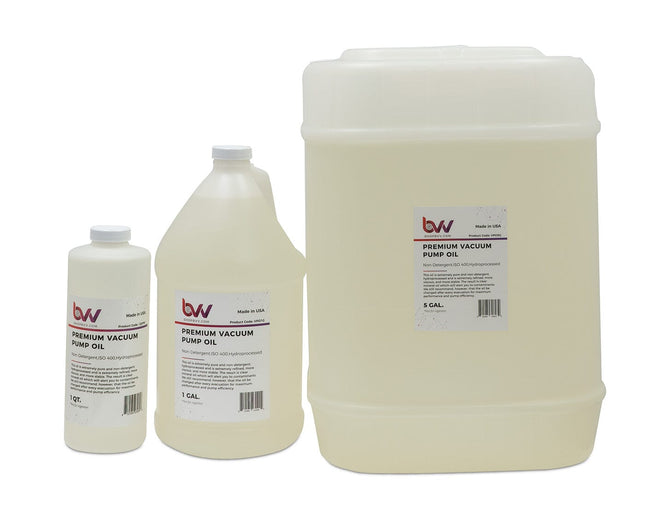
Premium Vacuum Pump Oil
Premium Vacuum Pump Oil For Maximum performance and pump efficiency, change the oil after every evacuation. After evacuation, oil contains contaminants which limit pump efficiency. Premium vacuum pump oil can be used in any vacuum pump to maintain and prolong the life of the pump. Drain immediately after evacuation while pump is warm. Slowly add oil to top of "oil level" line. If oil is to low, you will hear the exhaust baffle chatter. If oil level is too high, excess oil will be blown out of the exhaust. Non detergent-Extra Pure-Hydroprocessed-ISO 400 BVV Vacuum Pump Oil Certificate of Analysis COA BVV Vacuum Pump Oil Safety Data Sheet SDS
$19.63 - $1,332.07
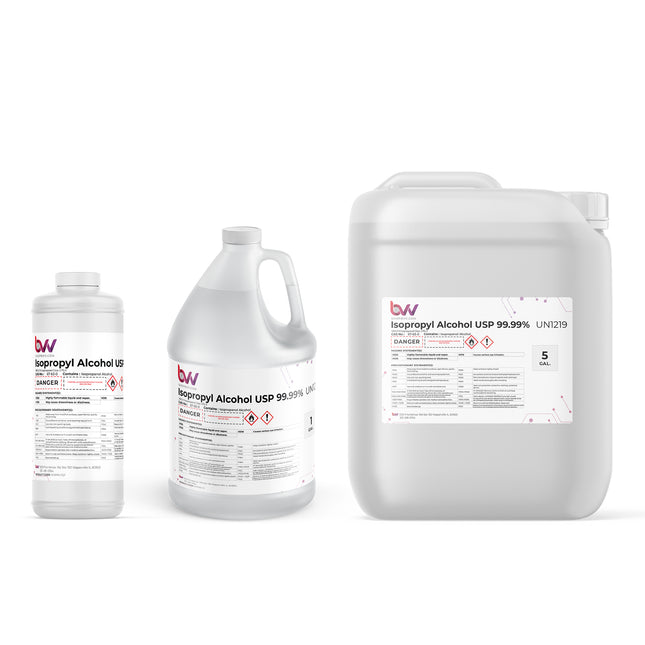
Isopropyl Alcohol 99% USP
Isopropyl Alcohol 99% USP Isopropyl alcohol, also known as 2-propanol or rubbing alcohol, is one of the most common alcohol solutions. The exact mechanism behind isopropanol’s disinfectant is not certain, however, it’s believed to kill cells through the process of denaturing cell proteins and DNA, dissolving cell lipoprotein membranes, and obstructing cellular metabolism. Isopropanol has a range of applications and uses across multiple industries, from medicine to cosmetics, and we explore this below. Cleaning Agent for Extraction, Laboratory, and Medical Industries In addition, 99% pure isopropyl alcohol serves as a cleaning agent for the laboratory, medical, and extraction industries. Mixed with water, this solution can be used as a rubbing-alcohol antiseptic. Quality solvents are vital for cleaning delicate electronics, extraction equipment, and other sensitive items. It also makes a perfect solution for surface disinfectant. 99% IPA evaporates cleanly and minimizes residual substances. Cleaning Agent for Home Care A truly versatile solution used in a variety of applications, isopropyl can also serve as a home cleaning remedy. For example, many window and toilet bowl cleaners contain isopropyl alcohol. rubbing alcohol can dissolve icky residues such as chewing gum, sap, hairspray, and other difficult compounds from hands, surfaces, and more. Other ways isopropyl can be used: Cleaning makeup brushes Cleaning blinds Cleaning sinks and chrome Deodorizing shoes Disinfecting computer mouse and keyboard Disinfecting mobile phone Dissolving windshield frost Getting rid of fruit flies Cleaning jewelry Creating homemade sanitizer Preventing ring around the collar Cleaning stainless steel Other Things to Note Spigots/Faucets are only compatible with 5 Gallon Jugs and must be purchased separately Isopropyl alcohol is a fast-evaporating solvent and industrial cleaning agent, intended for industrial or professional use only. It can be used as a solvent for gums, shellac, and essential oils. Can be used as a fuel additive. Isopropyl Alcohol (liquid) - 99.8% Purity Shelf Life - 5 years Specific Gravity - 0.79 Vapor Pressure - 1psi @ 20°C Flash Point - 12°C Boiling Point - 82°C *Disclaimer: 1 Quart Bottles are exempt from additional Hazmat shipping charges and can ship immediately, Less paperwork for shipping is required for shipping only 1 single bottle per order. Chemical Formula: C3H8O Molecular Weight: 60.096 g/mol CAS Registry Number: 67-63-0 Appearance Colorless Liquid Odor: Pungent Alcoholic odor Density 0.786 g/cm3 (20 °C) Boiling Point: 82.6 °C /180.7 °F Solubility in water: miscible GHS Pictograms: GHS Signal Word: Danger GHS Hazard Statements: H225, H302, H319, H336 GHS Precautionary Statements P210, P261, P305+P351+P338 UN Identification Number: 1219 Proper Shipping Name: Isopropanol Transport Hazard Class: 3 Packing Group: II DOT Placard: Isopropyl Alcohol Safety Data Sheet (SDS) Isopropyl Alcohol Certificate of Analysis (COA)
$25.24 - $4,451.93
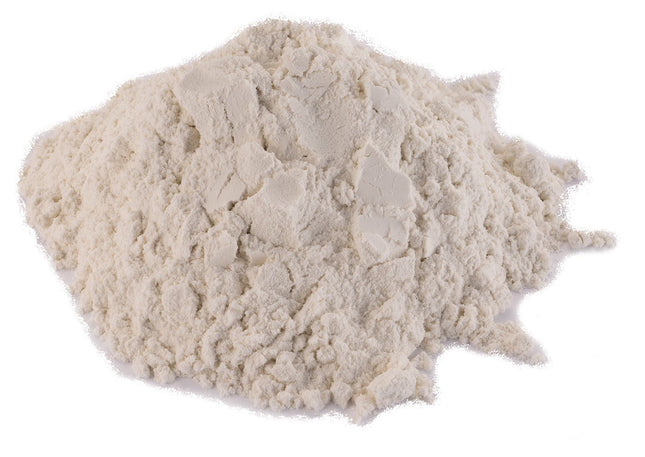
Celite® 545 Diatomaceous Earth (Food Codex Grade) 4.5 Micron
Celite® 545 Food Codex Chemicals Grade Filters down to 4.5 microns BVV™'s Celite 545 grade is Food Codex Grade and is approved for use as a filtering and processing aid in the Food Industry & is Made in the USA. Celite 545 is a formulation of Diatomaceous Earth that is used as a filtration aid for the pre-processing of distillate. Diatomaceous earth is considered skeletal remains of single-celled algae/diatoms formed due to sedimentary deposits. This filtration aid is used in laboratory settings and is a surface-active filtration agent that causes abrasion and the adsorption of other materials such as plant lipids. Celite 545 or Diatomaceous Earth is also an effective, safe alternative to chemical pesticides. This ultra-fine powder should be used with the proper safety equipment and should not be inhaled due to the risk of causing respiratory damage. pH: 10 (10% in Water) 90Kg Size sold at 4x 50lb bags on a Mini-Pallet* Safety Data Sheet Technical Data Sheet Certificate of Analysis Note: Bulk Bags and Bulk sizes are non-stocked items and will be ordered as needed and carry a several weeks lead time and require a forklift or pallet jack
$22.43 - $7,151.13
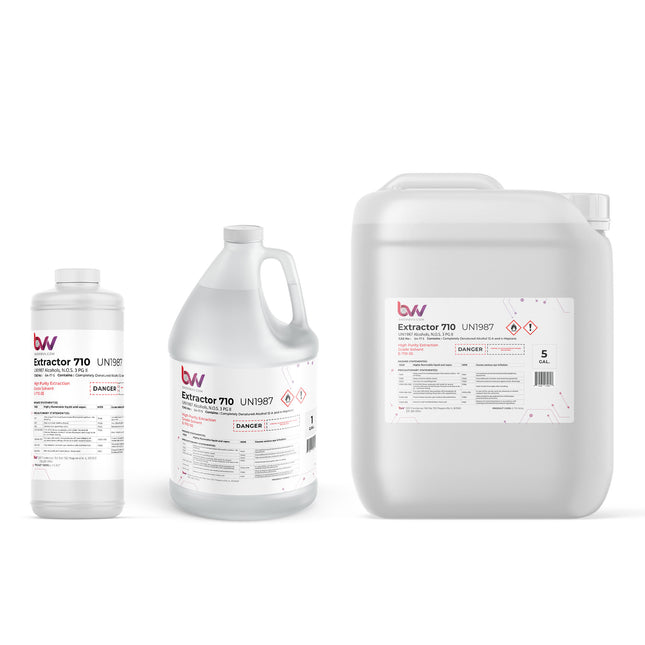
CDA-12A Denatured Ethanol n-Heptane
Ultra High Purity n-Heptane Denatured Ethanol - CDA 12A HAZMAT ITEMS ARE NON-REFUNDABLE. ALL SALES ARE FINAL (Note: Container style and color may vary) BVV's Ultra High Purity N-Heptane Denatured Ethanol (CDA 12A) is distinguished by its exceptional purity, Our CDA 12A formulation combines 95% Food Grade/USP/ACS 200 Proof Ethanol, derived from corn, with 5% high-purity N-Heptane. Adhering to stringent industry standards, ensuring it meets the precise requirements of our customers, our Ultra High Purity Heptane Denatured Ethanol excels across diverse applications widely adopted as an effective botanical extraction solvent and cleaning agent. Being that our Ultra High Purity Denatured Ethanol is made unfit for consumption when denatured with N-Heptane it is not subject to the Federal Excise Tax on alcohol saving you up to 72% without compromising on it suitability for top-tier extractions. Primarily utilized as pure ethanol in extraction processes, this solvent is favored for its cost-effectiveness and extraction efficiency. Reduce manufacturing costs and increase extraction efficiency with BVV's Ultra High Purity Heptane Denatured Ethanol. Key Features: Significantly Reduced Cost due to the absence of Federal Tax Produces Exceptional Quality Extractions Leaves No Residuals or Tastes Evaporates Completely in a Rotary Evaporator Chemical Formula: Ethanol C2H6ON-Heptane C7H16 Molecular Weight: 72.1057 CAS Registry Number: Ethanol 64-17-5N-Heptane142-82-5 Appearance Colorless Liquid Odor: Mint or acetone-like Density 0.7905g/cm³ Boiling Point: 78.5c/173.3F Solubility in water: Miscible GHS Pictograms: GHS Signal Word: Danger GHS Hazard Statements: H225, H319 GHS Precautionary Statements P210, P233, P240, P241, P242, P243, P261, P264, P271, P280, P303+P361+P353, P304+P340, P305+P351+P338, P312, P337+P313, P370+P378, P403+P233, P403+P235, P405, P501 UN Identification Number: 1987 Proper Shipping Name: Alcohols, N.O.S Transport Hazard Class: 3 Packing Group: I DOT Placard: What is Denatured Ethanol? Denatured ethanol, also known as denatured alcohol, is ethanol (ethyl alcohol) that has been rendered unfit for human consumption by the addition of denaturants. Denaturants are typically chemicals that make the ethanol taste bad or have toxic effects, and they are added to discourage people from drinking the substance. The denaturation process is done to avoid the high taxes and regulations associated with beverage alcohol, as denatured ethanol is intended for industrial, pharmaceutical, or cosmetic uses rather than for consumption. Common denaturants include heptane, methanol, isopropyl alcohol, acetone, and other chemicals. Denatured ethanol is widely used in various industries, such as in the production of paints, solvents, cleaning products, and as a fuel for alcohol burners. Why is Ethanol Denatured? Ethanol is denatured, or rendered undrinkable, for several reasons: Tax Purposes: Denaturing ethanol allows for the imposition of lower taxes on industrial or non-beverage alcohol compared to potable alcohol. Governments often place higher excise taxes on alcohol intended for human consumption. Regulatory Compliance: Denaturing ethanol is a regulatory requirement to discourage the illegal diversion of tax-free industrial alcohol for beverage use. The addition of denaturants makes it unpalatable and unsafe for consumption. Public Safety: Making ethanol undrinkable helps prevent accidental or intentional ingestion of industrial alcohol, which can be toxic. Denaturing agents are chosen to deter people from attempting to use denatured alcohol as a substitute for beverage alcohol. Industrial Use: Denatured ethanol is widely used in various industries, including pharmaceuticals, cosmetics, and manufacturing. It serves as a solvent, fuel, or raw material in these applications. Common denaturants include substances like heptane, methanol, isopropanol, and various chemicals that make the alcohol unsuitable for human consumption while maintaining its usability in industrial processes. The specific denaturing formulations, such as CDA 12-A mentioned earlier, are defined by regulatory agencies to ensure compliance with safety and tax regulations. What is denatured ethanol used for? Denatured ethanol is used for various industrial and commercial purposes where the alcohol is needed for its properties but should not be consumed. Here are some common applications: Industrial Solvent: Denatured ethanol is widely used as a solvent in industries such as pharmaceuticals, cosmetics, and manufacturing. It is effective in dissolving a variety of substances. Cleaning Agent: Due to its solvent properties, denatured ethanol is used as a cleaning agent for surfaces, equipment, and machinery in industrial and commercial settings. Fuel Additive: Denatured ethanol is sometimes used as a fuel additive, especially in the blending of gasoline. It can improve combustion efficiency and reduce emissions. Paint and Coating Industry: It is used as a solvent in the formulation of paints, varnishes, and coatings. Pharmaceuticals: Denatured ethanol is used in the pharmaceutical industry for various purposes, including the extraction of medicinal compounds. Laboratory Use: In laboratories, denatured ethanol is often used for tasks like sterilization and as a solvent for experiments. Inks and Dyes: It is employed in the production of inks and dyes due to its ability to dissolve pigments. Adhesives and Sealants: Denatured ethanol is used in the formulation of adhesives and sealants. Window Cleaning: It is used in commercial window cleaning solutions. Automotive Industry: In the automotive industry, denatured ethanol is used for cleaning and degreasing. What can be used to denature ethanol? Here are examples of common Completely Denatured Alcohol (CDA) formulations used to denature ethanol: CDA 12-A To every 100 gallons of alcohol, add either: Five gallons of heptane or 5 gallons of toluene. CDA-19 To every 100 gallons of ethyl alcohol (not less than 160 proof), add: 4.0 gallons of either methyl isobutyl ketone, mixed isomers of nitro propane, or methyln-butyl ketone 1.0 gallon of either kerosene, deodorized kerosene, gasoline, unleaded gasoline, rubber hydrocarbon solvent, or heptane. CDA-20 To every 100 gallons of ethyl alcohol (not less than 195 proof), add a total of: 2.0 gallons of either unleaded gasoline, rubber hydrocarbon solvent, kerosene, or deodorized kerosene, or any combination of these. What does CDA mean? Completely Denatured Alcohol (CDA) is a type of denatured alcohol that has been rendered unfit for human consumption by the addition of denaturing agents. Denatured alcohol is ethanol (ethyl alcohol) that has been intentionally adulterated to make it toxic, foul-tasting, or otherwise undrinkable. This denaturing process is done to exempt the alcohol from excise duty and other taxes, as it's not intended for use in beverages. The denaturing agents used in CDA can vary, but they often include chemicals such as methanol, isopropanol, or other substances that make the alcohol unpalatable and potentially harmful if ingested. The specific formulation of denatured alcohol may be regulated by government authorities to ensure it meets safety standards and legal requirements. CDA is commonly used in industrial applications, as a solvent, fuel, or as a cleaning agent. It's important to note that due to the addition of denaturing agents, CDA should not be used for purposes that involve contact with the human body or ingestion. Safety precautions, including proper ventilation, should be followed when working with denatured alcohol. What is CDA 12A? CDA 12-A is a formulation specified by the Alcohol and Tobacco Tax and Trade Bureau (TTB) for Completely Denatured Alcohol (CDA). The formula is defined under §21.26 as Formula No. 12-A. The composition of CDA 12-A is as follows: For every 100 gallons of alcohol, add either: 5 gallons of n-heptane or 5 gallons of toluene. This denaturing process renders the ethanol unfit for consumption while meeting regulatory requirements for various industrial applications. CDA formulations, including CDA 12-A, are used to denature ethanol for purposes such as industrial solvents, cleaning agents, and manufacturing processes. Can you remove heptane from CDA 12A? When n-Heptane is added to ethanol it creates an azeotrope between the ethanol and n-heptane. An azeotrope is defined as a mixture of two liquids that have a constant boiling point and composition through distillation. This azeotrope results in the ethanol and n-heptane evaporating at the same temperature, making it extremely difficult to separate the two through distillation. While these azeotropic solvents are still easily recovered from a botanical extract at a relatively low boiling point around 78C/173F using a rotary evaporator or falling film evaporator, it is near impossible to separate the two via distillation. What is an Azeotrope? An azeotrope is a mixture characterized by having identical concentrations in both its vapor and liquid phases. This stands in contrast to ideal solutions, where one component is usually more volatile than the other, allowing for separation through distillation. When an azeotrope forms, the concentrations in both phases remain the same, hindering separation through traditional distillation methods. Azeotropes consist of a blend of at least two different liquids, and this mixture can exhibit either a higher or lower boiling point than either of its individual components. Azeotropes become relevant when certain liquid fractions resist alteration through distillation processes. In typical mixtures, components can be extracted using Fractional Distillation, a process involving repeated distillation stages. The more volatile component vaporizes and is collected separately, while the less volatile component remains in the distillation container, resulting in two distinct, pure solutions. BVV™ 710 Extraction Solvent Safety Data Sheet (SDS) Pure Ethyl Alcohol USP Product Data Sheet (PDS) CDA-12 with nHeptane Certificate of Analysis (COA)
$16.83 - $2,664.15
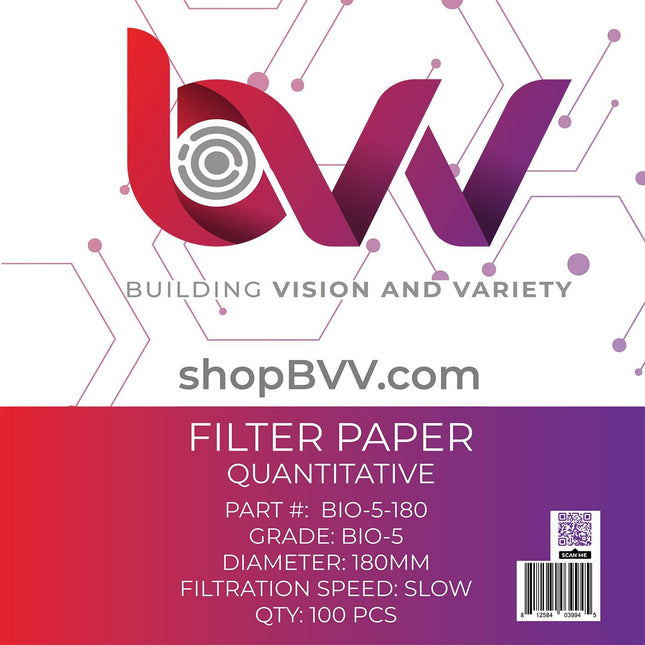
Ashless Filter Papers - 180MM - Quantitative
Ashless Filter Papers - 180MM - Quantitative Ashless quantitative and qualitative filter papers provide laboratory grade filtration for extraction systems and are specifically used in combination with a Buchner funnel to remove fats, waxes and any other unwanted contaminants from your solution. These filter papers are used in the pre-processing stage of short path distillation to clean up the material prior to processing. Key Features: ISO 9001 Approved Manufactured from alpha-cellulose and cotton linters High Purity and low background Consistent performance Low ashless content: <0.1% Whatman equivalent quality Pre-Cut for ease of use Specifications: Classification Qualitative Sizes Available: BIO-1 11um - Medium BIO-4 20um - Fast BIO-5 2.5um - Slow BIO-6 3um - Slow Ash Content <0.1% Quantity per Pack 100 Diameter 180mm (7.09") Technical Data: Grade Particle Retention Appearance Speed Ash Content (%) Basis Weight (g/m2) Wet burst (mm H2O) BIO-1 11um Smooth Medium <0.1 80.0±4.0 >140 BIO-2 8um Smooth Medium <0.1 80.0±4.0 >140 BIO-4 20um Smooth Fast <0.1 80.0±4.0 >120 BIO-5 2.5um Smooth Slow <0.1 80.0±4.0 >180 BIO-6 3um Smooth Slow <0.1 80.0±4.0 >180 BIO-40 8um Smooth Medium <0.007 80.0±4.0 >140 BIO-41 20-25um Smooth Fast <0.007 80.0±4.0 >120 BIO-42 2.5um Smooth Slow <0.007 80.0±4.0 >180 BIO-43 16um Smooth Medium to Fast <0.007 80.0±4.0 >120 BIO-44 3um Smooth Slow <0.007 80.0±4.0 >180
$58.89
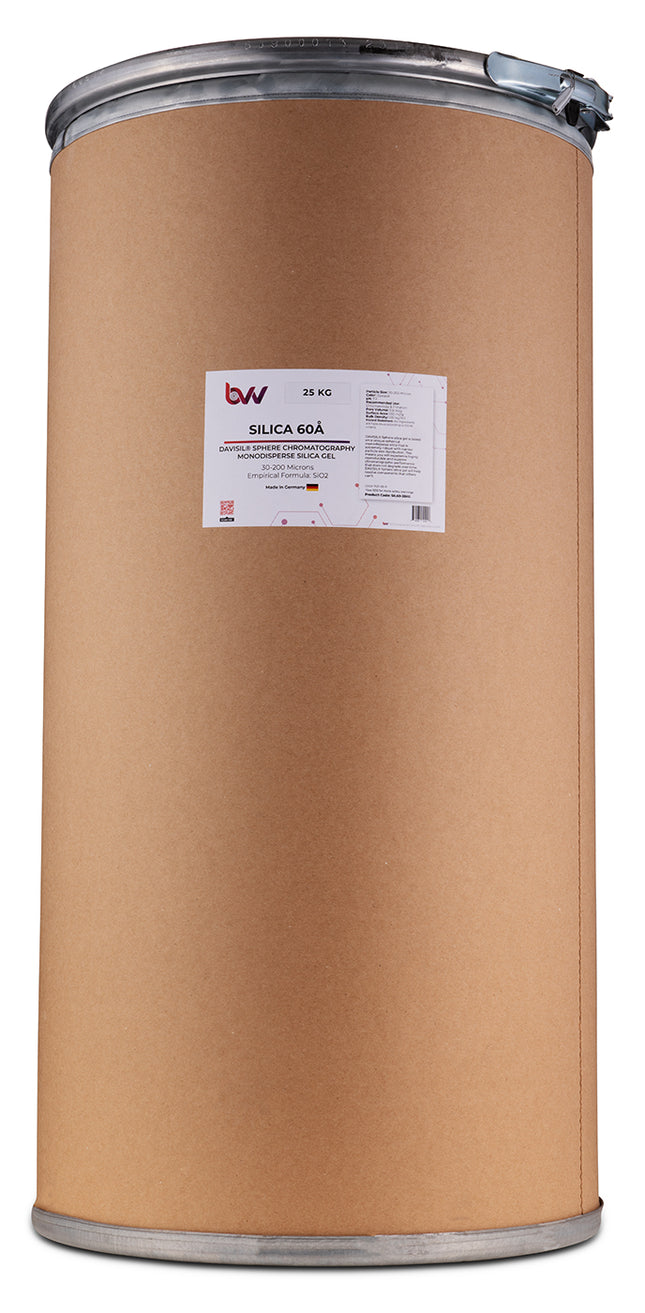
Chromatography Silica Gel 60A 30-200μm (Made in Germany)
Chromatography Silica Gel 60Å Silica gel consists of a granular, porous form of silicon dioxide synthetically made from sodium silicate (source). DAVISIL® 60Å 30-200μm Chromatographic Silica Gel is suitable for use as packing for liquid chromatography normal phase separations with low operating pressures, a substrate for supporting surface functionalization, and as an adsorbent in continuous processes. The 60 Angstroms pore size is the correct pore size for color remediation for the Hemp industry. Silica gel can be used for the cleanup and purification of a wide range of synthetic and natural compounds. Silica Gel is non-toxic, non-flammable, non-reactive, and is stable with ordinary usage. Storage in a dry warehouse is recommended. Open packages should be resealed to prevent contamination of the product. The material in standard packaging should be used within 24 months from the date of production. Made in Germany Certification DIN EN ISO 9001 DIN EN ISO 14001 DIN EN ISO 50001 DAVISIL® Silica Gel 60A 30-200μm Technical Data Sheet DAVISIL®Silica Gel 60A 30-200μm Safety Data Sheet Note: Bulk Bags and Bulk sizes are non-stocked items and will be ordered as needed and carry a several weeks lead time and require a forklift or pallet jack
$70.11 - $14,807.04
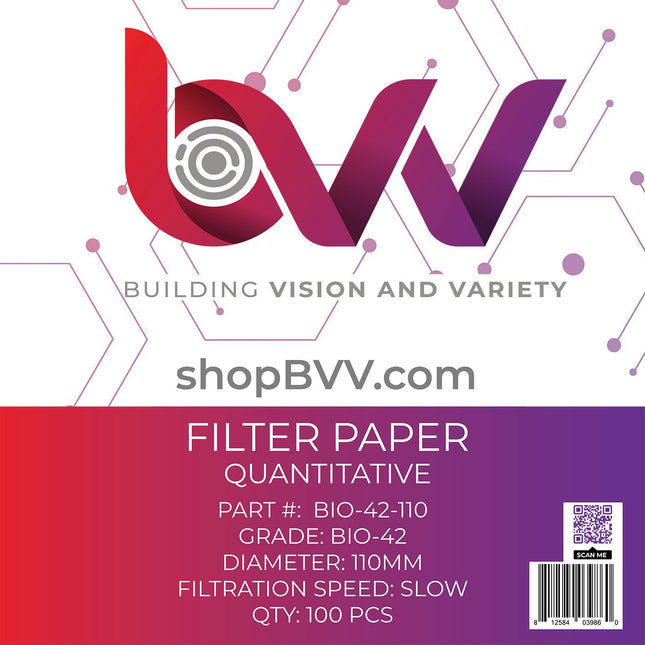
Ashless Filter Papers - 110MM - Quantitative
Ashless Filter Papers - 110MM - Quantitative Ashless quantitative and qualitative filter papers provide laboratory grade filtration for extraction systems and are specifically used in combination with a Buchner funnel to remove fats, waxes and any other unwanted contaminants from your solution. These filter papers are used in the pre-processing stage of short path distillation to clean up the material prior to processing. Key Features: ISO 9001 Approved Manufactured from alpha-cellulose and cotton linters High Purity and low background Consistent performance Low ashless content: <0.007% (Quantitative Filter Paper) Whatman equivalent quality Pre-Cut for ease of use Specifications: Classification Quantitative Sizes Available: BIO-40 8um - Medium BIO-41 20-25um - Fast BIO-42 2.5um - Slow BIO-44 3um - Slow Ash Content <0.007% Quantity per Pack 100 Diameter 110mm (4.33") Technical Data: Grade Particle Retention Appearance Speed Ash Content (%) Basis Weight (g/m2) Wet burst (mm H2O) BIO-1 11um Smooth Medium <0.1 80.0±4.0 >140 BIO-2 8um Smooth Medium <0.1 80.0±4.0 >140 BIO-4 20um Smooth Fast <0.1 80.0±4.0 >120 BIO-5 2.5um Smooth Slow <0.1 80.0±4.0 >180 BIO-6 3um Smooth Slow <0.1 80.0±4.0 >180 BIO-40 8um Smooth Medium <0.007 80.0±4.0 >140 BIO-41 20-25um Smooth Fast <0.007 80.0±4.0 >120 BIO-42 2.5um Smooth Slow <0.007 80.0±4.0 >180 BIO-43 16um Smooth Medium to Fast <0.007 80.0±4.0 >120 BIO-44 3um Smooth Slow <0.007 80.0±4.0 >180
$58.89
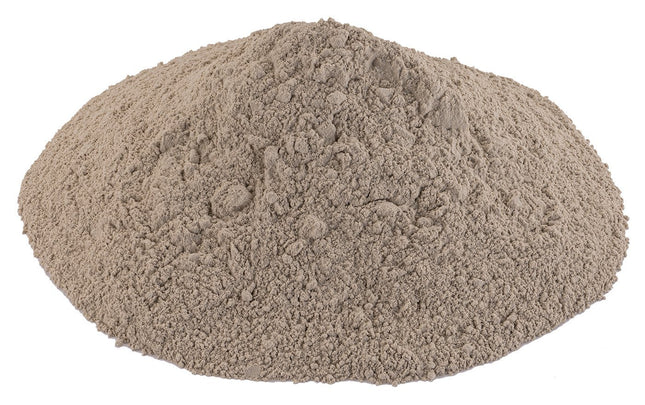
Activated Bentonite Clay T-5™
Activated Bentonite Clay T-5™ BVV™ activated Bentonite Clay T-5™ is a highly effective decolorizing agent for filter organic materials. This Clay is tan in color and is Heat Activated to help remove Anthocyanin pigments while preventing isomerization. This is a slow filtering media but will produce high clarity when used as a filter aid. pH:5 BVV™ Activated Bentonite Clay T-5™
$30.85 - $2,699.20
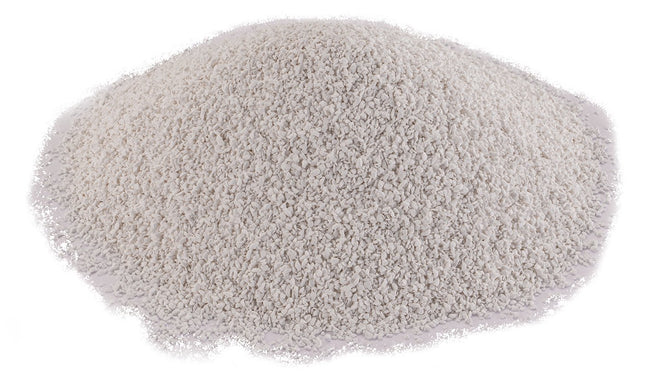
Activated Alumina
Activated Alumina Activated Alumina also known as aluminum oxide is one of the most adaptable sorbents for preparative flash and column chromatography. NSF 61 certified & Made in USA, Purity: <=100%. Based on 8% loss on Ignition. Activated Alumina SDS Sheet Activated Alumina Technical Data Sheet Key Uses: Purification of natural products & herbals As a supportive agent in aromatice chromatography Dehydration of organic solvents. Dehydration of organic solvents. Removal of water from non-polar solvents NSF 61 Certified: Guaranteed the product is free of harmful chemicals, and can be used in systems that humans come into contact consuming. Lot certificates can be available per request. Chemical composition (%) Al2O3 92 Na2O 0.35 SiO2 0.03 LOI (1000ºC) 8.0 Total pore volume, cc/g 0.52 0.52 Surface area, m2/g 380 Note: Bulk bags and Bulk sizes are non-stocked items and will be ordered as needed and carry a several week lead time and require a forklift or pallet jack Note: Container style and color may vary. Product is sold by weight which may result in container not being full.
$28.04 - $8,763.64
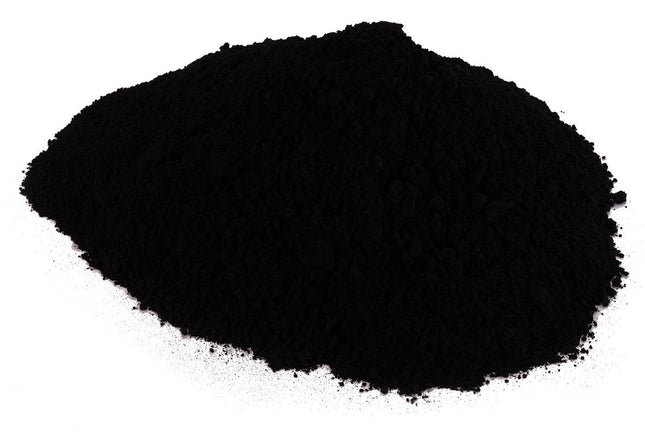
Activated Hardwood Carbon (Charcoal)
Activated Carbon Decolorizing T1 100% Hardwood NSF 61 & UL Classified for food and Consumption Contact BVV™ Activated Carbon or Charcoal powder is some of the highest purity and quality activated charcoal on the market. Made in the USA, and 100% Hardwood. Activated charcoal can be used for several processes in the laboratory and can be most importantly used for the removal of color, unwanted chemical impurities, and unwanted flavors in the starting material resulting in a more refined purer end substance. Each bag includes a 5cc scoop inside. pH:7NSF 61 Certified & UL Classified. Guaranteed the product is free of harmful chemicals, and can be used in systems that humans come into contact consuming. Lot certificates can be available per request. BVV™ Activated Carbon Technical Data Sheet BVV™ Activated Carbon Decolorizing T1 SDS Note: Bulk Bags and Bulk sizes are non-stocked items and will be ordered as needed and carry a several weeks lead time and require a forklift or pallet jack
$67.30 - $4,907.64
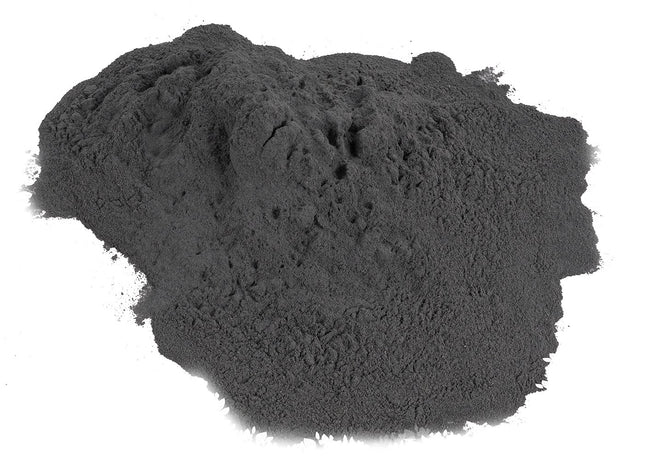
Color Bleach (Compares to T-41 and CR41)
Color Bleaching Clay This product is similar to T-41, as it is an Acid Activated Bentonite Clay for Bleaching & Decolorizing Edible Oils. BVV™ Color Bleach is a filtration aid used in refining and increasing the purity and clarity of the final product. The BVV™ Clay Bleach is composed of a 10:1 ratio of Pure-Flo® Perform 6000 and BVV™ T-1 Hardwood Activated Carbon. This product is 100% made in the USA, and the components are FDA-GRAS and NSF Certified. This bleaching clay not only improves the purity and clarity of the end product, it also improves the color and clarity. This is a strong acid-activated media and the acid will be critical in removing red, purple, and blue pigments known as Anthocyanins. This media can be used in a Color Remediation Column, or between Short Path Distillation runs with a Hot Scrub, to make your distilled oil clean and more clear. Key features of Color Bleach for Edible Oils: • Excellent metals adsorption characteristics (P, Ca, Fe, Mg, Ni, etc.)• Outstanding color, and chlorophyll removal from oil. • Removes soaps and phospholipids• Enhanced removal of chlorophyll from added Hardwood Carbon.• Fast filtering characteristics, including long filtration cycles and lesspressure build-up at cycle end. pH: 3.0 FDA: GRAS (Generally Recognized as Safe) - This product is safe for processing food, as long as its not part of the end product being consumed. NSF: HACCP *Prior to down packing this product was certified Kosher & Hallal. It does not retain its certifications after down packing, BVV™ doesn't have an on-staff Rabbi or Imam on-site to re-establish religious certifications for this product. Safety Data Sheet: BVV™ Color Bleach SDS BVV™ Color Bleach Technical Data Sheet
$49.08 - $2,103.27
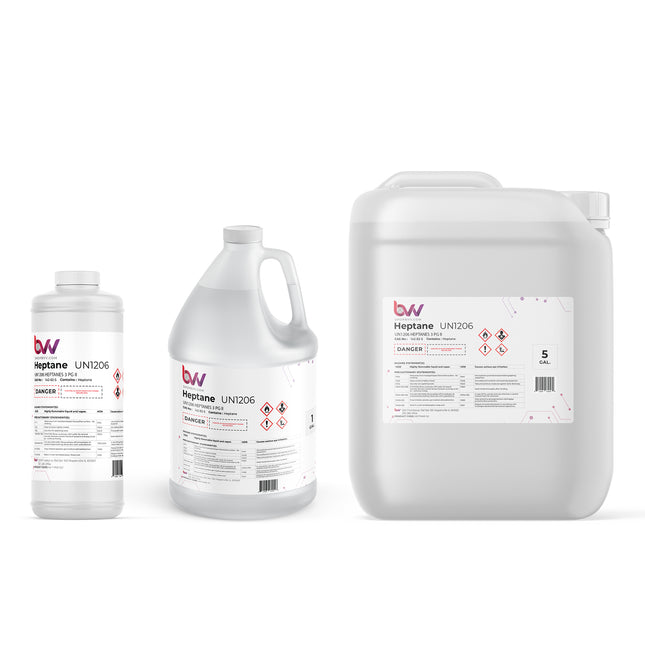
Heptane 99% Lab Grade
BVV™ High Purity Lab Grade Heptane (Note: Container style and color may vary) Experience the Exceptional Utility of BVV™ High Purity Lab Grade Heptane in Crystallization and Liquid-Liquid Extraction When it comes to achieving impeccable results in crystallization and liquid-liquid extraction processes, BVV™ High Purity Lab Grade Heptane stands out as the ideal choice. This versatile solvent has been meticulously refined to meet the exacting standards of laboratory and industrial applications, offering unparalleled purity and performance. Why Choose BVV™ High Purity Lab Grade Heptane: Unrivaled Purity: Our heptane boasts an exceptional level of purity, minimizing unwanted impurities and contaminants in your final products. Reliable Performance: Count on BVV™ High Purity Lab Grade Heptane to consistently deliver outstanding results, batch after batch. Versatile Solvent: From crystallization to liquid-liquid extraction, this solvent adapts to various applications, providing flexibility and convenience. Trusted by Professionals: Trusted by laboratories, industries, and professionals worldwide, BVV™ High Purity Lab Grade Heptane is the go-to choice for achieving exceptional purity and clarity in your processes. Elevate your crystallization and liquid-liquid extraction procedures to new heights of precision and quality with BVV™ High Purity Lab Grade Heptane. Discover the difference that purity and performance can make in your applications. Choose BVV™ High Purity Lab Grade Heptane for your next project and unlock the full potential of your crystallization and liquid-liquid extraction processes. Chemical Formula: C7H16 Molecular Weight: 100.205 g·mol−1 CAS Registry Number: 142-82-5 Appearance Colorless Liquid Odor: Petrolic Density 0.6795 g cm−3 Boiling Point: 98.38 °C /209.08 °F Solubility in water: 0.0003% (20 °C GHS Pictograms: GHS Signal Word: Danger GHS Hazard Statements: H225, H304, H315, H336, H410 GHS Precautionary Statements P210, P261, P273, P301+P310, P331 UN Identification Number: 1206 Proper Shipping Name: Heptanes Transport Hazard Class: 3 Packing Group: II DOT Placard: What is Heptane? Heptane is a hydrocarbon compound belonging to the alkane family, which means it consists of hydrogen and carbon atoms arranged in a linear, unbranched chain. Specifically, heptane has seven carbon atoms and sixteen hydrogen atoms, giving it the chemical formula C7H16. It is a colorless, flammable liquid with a gasoline-like odor. Heptane is one of several isomers of the alkane series with seven carbon atoms. It is known for its role as a common solvent in various applications, including laboratory work, chemical processes, and industrial settings. Due to its purity and low reactivity, heptane is often used as a standard reference compound in gas chromatography. Heptane is also used as a fuel component in gasoline, although it is less common than other hydrocarbons like octane. Its properties and applications make it a valuable chemical compound in both the scientific and industrial sectors. What Is Heptane Used For? Heptane has a wide range of applications due to its properties as a hydrocarbon solvent. Some of the common uses of heptane include: Solvent: Heptane is widely used as a solvent in various industries, including chemistry, pharmaceuticals, and manufacturing. It is especially favored for its ability to dissolve a wide range of organic compounds and its low reactivity, which makes it suitable for cleaning, degreasing, and extracting chemicals from natural products. Laboratory and Scientific Research: Heptane is often used in laboratories for tasks such as extracting natural products, preparing chemical samples, and conducting chromatography experiments. Its purity and low reactivity make it a valuable solvent in scientific research. Industrial Cleaning: Heptane is an effective degreaser and cleaner for machinery, equipment, and surfaces in industrial settings. It is commonly used to remove oil, grease, and contaminants from various surfaces. Adhesives and Coatings: Heptane is used in the formulation of adhesives, coatings, and paints. It helps dissolve the components of these products and provides them with the desired consistency. Fuel: While less common than other hydrocarbons like octane, heptane is used as a component in gasoline. It contributes to the overall fuel mixture, affecting properties such as octane rating and combustion characteristics. Extraction: Heptane is employed in the extraction of natural compounds, such as essential oils and flavors, from plant materials. It is particularly useful for extracting nonpolar compounds. Calibration Standard: Heptane is used as a reference compound in gas chromatography and other analytical techniques to calibrate instruments and assess the performance of chromatographic columns. Solvent for Rubber and Plastics: In the rubber and plastics industry, heptane is used as a solvent for processing and manufacturing these materials. Chemical Synthesis: Heptane can be used as a reactant or solvent in chemical synthesis processes to produce various organic compounds. It's important to note that heptane should be handled with care, especially in industrial and laboratory settings, due to its flammability and potential health hazards. Proper safety measures and ventilation are essential when working with this solvent. How Is Heptane Produced? Heptane is primarily produced through the refining of crude oil, a process that separates hydrocarbons of different chain lengths. Here's a simplified overview of the production process: Crude Oil Refining: The production of heptane begins with the refining of crude oil, which contains a mixture of hydrocarbons with varying chain lengths and properties. Fractional Distillation: In the refining process, crude oil is heated and subjected to fractional distillation. This process separates the crude oil into various fractions based on boiling points. Heptane falls within a specific range of boiling points and is separated from other hydrocarbons during this distillation process. Fraction Separation: Once the appropriate fraction is obtained, further separation may be necessary to isolate pure heptane. This can involve additional distillation or purification techniques to remove impurities and other hydrocarbons. Quality Control: The resulting heptane undergoes quality control measures to ensure that it meets the required specifications and purity standards for its intended applications. Quality control may include testing for impurities, moisture content, and other properties. Packaging and Distribution: After quality control, heptane is packaged into containers suitable for its intended use and distribution to various industries and customers. It's worth noting that heptane can also be produced synthetically through chemical processes, such as the hydrogenation of hexene or the cracking of longer hydrocarbon chains. However, the primary source of heptane for industrial and commercial applications is typically derived from crude oil refining due to its cost-effectiveness and abundance. What Are The Hazards Of Heptane? Heptane, a highly flammable hydrocarbon, poses several hazards that individuals and workers should be aware of when handling or working with it. Here are some of the key hazards associated with heptane: Flammability: Heptane is extremely flammable and can ignite easily in the presence of open flames, sparks, or heat sources. It has a wide flammable range and can form explosive mixtures with air. Adequate ventilation and proper storage precautions are essential to prevent fires and explosions. Vapor Inhalation: Inhaling heptane vapors can lead to health risks, including dizziness, headaches, nausea, and respiratory irritation. Prolonged exposure to high concentrations of heptane vapor can result in more severe health effects, such as central nervous system depression and damage to the respiratory system. Skin Contact: Heptane can cause skin irritation and may lead to dermatitis or chemical burns upon prolonged or repeated contact. It can also defat the skin, removing protective oils and potentially resulting in dryness and cracking. Eye Contact: Contact with heptane can cause eye irritation, redness, and discomfort. Proper eye protection, such as safety goggles or a face shield, should be worn when handling heptane to prevent eye exposure. Ingestion: Swallowing heptane can be harmful and should be avoided. Ingestion of heptane may lead to gastrointestinal distress, nausea, vomiting, and abdominal pain. Environmental Impact: Spills or improper disposal of heptane can have negative environmental consequences. Heptane is volatile and can contribute to air pollution. It may also contaminate soil and water if not handled and disposed of properly. Occupational Exposure Limits (OELs): Regulatory authorities, such as OSHA in the United States, have established occupational exposure limits for heptane to protect workers. Adhering to these limits and implementing proper safety measures in the workplace is essential to mitigate exposure risks. It's crucial to handle heptane with caution, follow safety protocols, and use appropriate personal protective equipment (PPE) when working with this solvent. Additionally, safe storage, handling, and disposal practices are essential to minimize the associated hazards and ensure workplace safety. How Can I Safely Use Heptane? Safely using heptane requires following proper procedures and precautions to minimize risks associated with this flammable solvent. Here are some essential guidelines for the safe handling and use of heptane: Personal Protective Equipment (PPE): Wear appropriate PPE, including safety goggles or a face shield, chemical-resistant gloves, lab coats, and closed-toe shoes, to protect your eyes, skin, and clothing from exposure to heptane. Ventilation: Work in a well-ventilated area or use a chemical fume hood to prevent the buildup of heptane vapors. Ensure adequate airflow to disperse fumes. No Open Flames or Sparks: Avoid open flames, sparks, or heat sources in the vicinity of heptane. Heptane is highly flammable and can ignite easily. Electrical Equipment: Use explosion-proof or intrinsically safe electrical equipment and fixtures in areas where heptane is used or stored. Storage: Store heptane in approved safety containers, away from heat sources, direct sunlight, and incompatible materials. Keep containers tightly sealed when not in use. Handling and Transfer: Use spark-resistant tools and equipment when handling heptane. Avoid rough handling or transferring the solvent near open flames or hot surfaces. Spill Response: Have spill response materials, such as absorbent materials and spill kits, readily available to contain and clean up any heptane spills promptly. Labeling: Clearly label heptane containers with appropriate hazard warnings and information to identify the contents. Emergency Equipment: Maintain access to safety equipment, including emergency eyewashes, safety showers, and fire extinguishers, in the workspace. Training: Ensure that personnel handling heptane receive proper training on its hazards, safe handling procedures, and emergency response protocols. Avoiding Skin Contact: Minimize skin contact with heptane. In case of contact, wash the affected area immediately with soap and water. Use barrier creams or protective clothing as an additional precaution. Eye Protection: Wear safety goggles or a face shield to protect your eyes from splashes or accidental exposure. No Smoking or Eating: Prohibit smoking, eating, or drinking in areas where heptane is present, as ingestion or inhalation of heptane can be harmful. Disposal: Follow proper waste disposal procedures for heptane and other hazardous materials. Dispose of waste in accordance with local regulations. Emergency Response: Establish and communicate emergency response procedures for heptane-related incidents, including fire, spills, and exposure incidents. Regular Inspections: Conduct regular inspections of equipment, storage areas, and safety measures to ensure they remain in good condition. It's essential to adhere to safety guidelines, have safety protocols in place, and prioritize the well-being of personnel when working with heptane. Always consult safety data sheets (SDS) and regulatory guidelines specific to heptane in your region for additional safety information and requirements. Is Heptane Miscable With Water? Heptane is not miscible with water. It is considered hydrophobic, which means it does not mix well with water and tends to form separate layers when combined. What Is The Flash Point Of Heptane? The flash point of heptane, specifically n-heptane, is approximately -4 degrees Celsius (24.8 degrees Fahrenheit). This is the temperature at which it can produce enough vapor to ignite briefly if exposed to an open flame or spark. Heptane is considered highly flammable and should be handled with caution in environments where there is a risk of ignition. Heptane Certificate of Analysis (COA) Heptane Safety Data Sheet (SDS)
$25.24 - $855.33
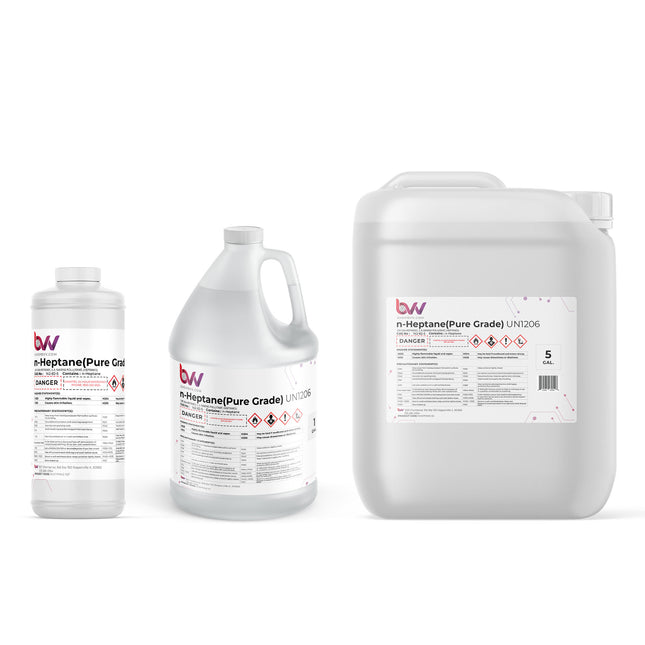
N-Heptane 99.3% Lab Grade
ULTRA High Purity Lab Grade N-Heptane 99.3% Purity (Note: Container style and color may vary) BVV™ ULTRA High Purity Lab Grade N-Heptane is a perfect solution for cleaning up and clarifying the extracted material and removing the green colored plant material and some waxes out of the product to produce a cleaner end result when distilling extracts. Heptane can be used the same as hexane or as a solvent, but has a higher boiling point when needing to remove residuals from extracted material. Chemical Formula: C7H16 Molecular Weight: 100.205 g·mol−1 CAS Registry Number: 142-82-5 Appearance Colorless Liquid Odor: Petrolic Density 0.6795 g cm−3 Boiling Point: 98.38 °C /209.08 °F Solubility in water: 0.0003% (20 °C GHS Pictograms: GHS Signal Word: Danger GHS Hazard Statements: H225, H304, H315, H336, H410 GHS Precautionary Statements P210, P261, P273, P301+P310, P331 UN Identification Number: 1206 Proper Shipping Name: Heptanes Transport Hazard Class: 3 Packing Group: II DOT Placard: N-Heptane Safety Data Sheet (SDS) N-Heptane Certificate of Analysis (COA)
$28.04 - $1,191.85
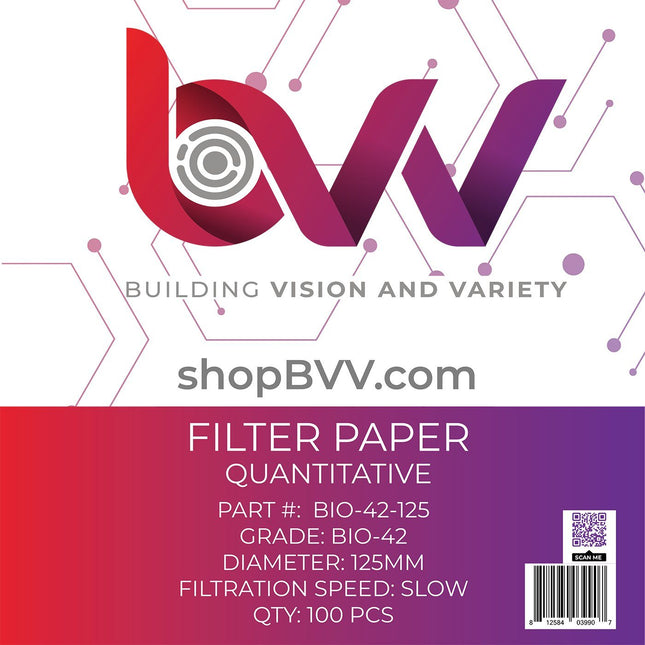
Ashless Filter Papers - 125MM - Quantitative
Ashless Filter Papers - 125MM - Quantitative Ashless quantitative and qualitative filter papers provide laboratory grade filtration for extraction systems and are specifically used in combination with a Buchner funnel to remove fats, waxes and any other unwanted contaminants from your solution. These filter papers are used in the pre-processing stage of short path distillation to clean up the material prior to processing. Key Features: ISO 9001 Approved Manufactured from alpha-cellulose and cotton linters High Purity and low background Consistent performance Low ashless content: <0.007% (Quantitative Filter Paper) Whatman equivalent quality Pre-Cut for ease of use Specifications: Classification Quantitative Sizes Available: BIO-40 8um - Medium BIO-41 20-25um - Fast BIO-42 2.5um - Slow BIO-44 3um - Slow Ash Content <0.007% Quantity per Pack 100 Diameter 125mm (4.92") Technical Data: Grade Particle Retention Appearance Speed Ash Content (%) Basis Weight (g/m2) Wet burst (mm H2O) BIO-1 11um Smooth Medium <0.1 80.0±4.0 >140 BIO-2 8um Smooth Medium <0.1 80.0±4.0 >140 BIO-4 20um Smooth Fast <0.1 80.0±4.0 >120 BIO-5 2.5um Smooth Slow <0.1 80.0±4.0 >180 BIO-6 3um Smooth Slow <0.1 80.0±4.0 >180 BIO-40 8um Smooth Medium <0.007 80.0±4.0 >140 BIO-41 20-25um Smooth Fast <0.007 80.0±4.0 >120 BIO-42 2.5um Smooth Slow <0.007 80.0±4.0 >180 BIO-43 16um Smooth Medium to Fast <0.007 80.0±4.0 >120 BIO-44 3um Smooth Slow <0.007 80.0±4.0 >180
$63.10 - $70.11
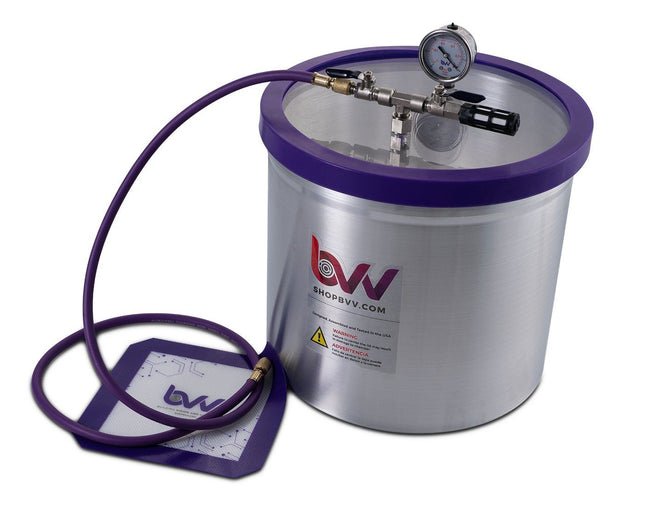
Best Value Vacs 5 Gallon Aluminum Vacuum Chamber
5 Gallon Vacuum & Degassing Chamber (Comes with 2 yr Limited Warranty) This is a complete BestValueVac® vacuum chamber setup designed built and 100% tested in Naperville, Illinois. With our unique patent-pending gasket design (Patent #9475627) this chamber is sure to last 10,000 uses with proper care and maintenance. The gasket itself is reversible (doubling the life of our system) allowing customers to instantly take it off and flip it over. Every chamber is tested prior to shipping to lose no more than 2.5Hg/24hrs. -Please Refer to these charts for vacuum specifications at altitude and conversions: Vacuum at Altitude Chart Vacuum Conversion Chart Key Features: Aluminum Vessel Highly Durable and Reversible Silicone Gasket Glycerin filled vacuum gauge User friendly vacuum connections that fit most vacuum pumps on the market 50 Micron Air filter for reducing airborne contaminants when releasing the vacuum Silicone vacuum pad 5' of vacuum rated HVAC hose to pull a vacuum. Specifications Chamber Material 3004 Aluminum Gasket Material Silicone Lid Material Acrylic Internal Dimensions (ID) 10" Tall x 12" Diameter Vacuum Gauge (Glycerin Filled) InHG (0)-(-30) Manifold Connections 1/4" SAE and 1/4" FNPT Temperature Rating 150°F (65°C) Additional Included Items 5' Purple Vacuum Rated HVAC Hose Platinum Cured Silicone Pad Black 50 Micron Air Filter Compatibility Explanation: BestValueVac® Chambers are not compatible with stabilization resin (i.e. Cactus Juice™, Gator Venom™, Minwax™ etc.), alcohol, ethanol, acetone and acrylic-based monomers or polymers.The lid may only be cleaned with soapy water. ShatterVac® chambers are not compatible with stabilization resin (i.e. Cactus Juice™, Gator Venom™, Minwax™ etc.), acetone, acrylic-based monomers or polymers. The lid may be cleaned with soapy water and low strength cleaning agents. GlassVac® chambers are compatible with all solvents and stabilization resins. We only recommend and warranty GlassVac® chambers for resin infusion and wood stabilization. The lid may be cleaned with any solvent or cleaning agent. See FAQ at the top for product safety warnings. Pump Warranty Information: Customers using solvents such as stabilization resins (MinWax™, Gator Venom™ etc.), alcohol and other polar solvents must use the vacuum pumps in conjunction with a cold trap for evacuations in excess of 5 minutes. (Excludes Cactus Juice™) If the consumer is using the pump for prolonged periods of time exceeding 5 minutes we require that a cold trap is used or the pump warranty is void. These stabilization resins have the ability to break down the internal components of the pump that are plastic resulting in a seized motor voiding all warranties. When evacuation exceeds 5 minutes these solvents begin to vaporize and then re-condense in the vacuum pump reservoir. Once enough solvent re-condenses in the pump displacing the oil the plastic internal components may begin to warp, melt or seize. The use of a cold trap will condense the vapors prior to making their way to the vacuum pump preventing pump damage due to excessive use. Furthermore, Minwax Wood Hardener™ is not to be used with any vacuum pumps, EVER. (A seized motor will result within the first use.) To prevent these issues from happening to your process, change the Oil after each vacuum pump use, Even if the use time is only 5min. For shipping info including Import/Export details visit our Shipping link at the bottom of the page.
$238.37
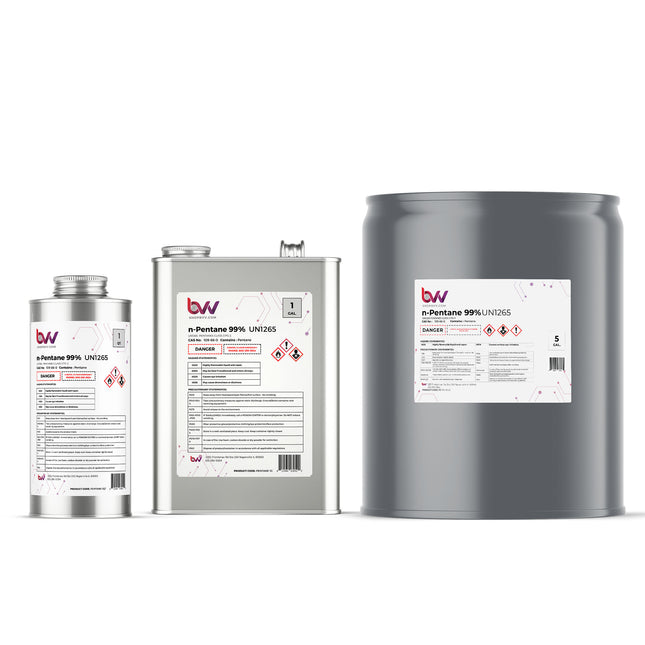
N-Pentane 99% Lab Grade
BVV™ High Purity Lab Grade N-Pentane 99% (Note: Container style and color may vary) BVV™ High Purity Lab Grade n-Pentane 99% is a hydrocarbon that has properties that are similar to butanes and hexanes. Pentane is a non-polar solvent and refrigerant. Pentane is used for the extraction and eluting of distillates, concentrates, volatiles, and essential oils from plant materials. Pentane can be used with hydrocarbon extraction systems that extract herbal oils, botanical compounds and oils from plants. It is a colorless liquid and has a petroleum-like odor. Chemical Formula: C5H12 Molecular Weight: 72.151 g·mol−1 CAS Registry Number: 109-66-0 Appearance Colorless Liquid Odor: Gasoline-like Density 0.6262 g/mL (20 °C) Boiling Point: 35.9°C /96.5 °F Solubility in water: 40 mg/L (20 °C) GHS Pictograms: GHS Signal Word: Danger GHS Hazard Statements: H225, H304, H336, H411 GHS Precautionary Statements P210, P261, P273, P301+P310, P331 UN Identification Number: 1265 Proper Shipping Name: Pentanes Transport Hazard Class: 3 Packing Group: II DOT Placard: What Is N-Pentane? N-Pentane, also known as normal pentane, is a straight-chain alkane hydrocarbon with the molecular formula C5H12. It is one of the isomers of pentane, a hydrocarbon that consists of five carbon atoms bonded together in a linear, unbranched chain. n-Pentane is called "normal" because its carbon atoms are arranged in a continuous, straight chain, without any branching. What Are The Properties Of N-Pentane? Here are some of the key properties of n-pentane: Physical State: At room temperature and standard atmospheric pressure, n-pentane is a colorless, clear, and highly flammable liquid. Odor: It has a gasoline-like or organic solvent-like odor. Boiling Point: The boiling point of n-pentane is approximately 36.1 degrees Celsius (97 degrees Fahrenheit). This relatively low boiling point makes it useful in various applications. Density: The density of n-pentane at room temperature is about 0.626 grams per milliliter (g/mL). It is less dense than water, which has a density of 1 g/mL. Solubility: n-Pentane is sparingly soluble in water, which means it does not readily mix with water. This is because it is a nonpolar compound, and water is a polar solvent. However, it is highly soluble in nonpolar solvents and organic compounds. Flammability: n-Pentane is highly flammable and poses a fire hazard. It has a low flash point and can easily ignite when exposed to an open flame or heat source. Vapor Pressure: It has a relatively high vapor pressure at room temperature, meaning it readily evaporates into the air. Chemical Structure: As a straight-chain alkane, n-pentane consists of five carbon atoms bonded together in a linear fashion, with 12 hydrogen atoms bonded to these carbons. Molar Mass: The molar mass of n-pentane is approximately 72.15 grams per mole (g/mol). Reactivity: n-Pentane is relatively unreactive under normal conditions and does not readily undergo chemical reactions with common reagents. Uses: It is used as a laboratory solvent, industrial solvent, component in fuel blends, foam blowing agent, and as a chemical reagent in various applications. Safety Precautions: Due to its high flammability, proper safety precautions should be taken when handling n-pentane. It should be stored away from open flames, sparks, and heat sources. Environmental Impact: Like other hydrocarbons, the combustion of n-pentane releases carbon dioxide and other greenhouse gases into the atmosphere, contributing to climate change. n-Pentane is commonly employed in laboratory and industrial settings as a solvent, and its physical and chemical properties make it suitable for various applications. However, its flammability requires careful handling and storage to prevent accidents. What Is The Difference between N-Pentane and ISO-Pentane? n-Pentane and isopentane are two different structural isomers of pentane, each with distinct molecular arrangements. Here are the key differences between n-pentane and isopentane: Structural Arrangement: n-Pentane (Normal Pentane): n-Pentane has a linear, straight-chain structure with five carbon atoms connected in a continuous, unbranched chain. It is sometimes referred to as "normal" pentane due to its unbranched structure. Isopentane (2-Methylbutane): Isopentane has a branched-chain structure with one methyl (CH3) group branching off from the second carbon atom (C2) of the main carbon chain. This branching gives it its common name, "isopentane." Physical Properties: n-Pentane: n-Pentane is a clear, colorless liquid at room temperature and atmospheric pressure. It has a higher boiling point than isopentane and is less volatile. Isopentane: Isopentane is also a clear, colorless liquid at room temperature, but it has a lower boiling point compared to n-pentane. It is more volatile and evaporates more easily. Boiling Points: n-Pentane: The boiling point of n-pentane is approximately 36.1 degrees Celsius (97 degrees Fahrenheit). Isopentane: The boiling point of isopentane is lower, at approximately -11.7 degrees Celsius (11 degrees Fahrenheit). This lower boiling point makes it more suitable for certain applications. Applications: n-Pentane: n-Pentane is used as a laboratory solvent, in the formulation of industrial solvents, and as a component in gasoline and other fuels. Its relatively higher boiling point makes it less volatile and suitable for some applications where slow evaporation is desired. Isopentane: Isopentane is commonly used as a refrigerant and as a component in aerosol propellants, blowing agents for foam production, and as a solvent. Its lower boiling point and greater volatility make it useful in these applications. In summary, n-pentane and isopentane differ in their molecular structures, physical properties, boiling points, and applications. The choice between the two depends on the specific requirements of a given application, with n-pentane being less volatile and isopentane being more volatile. What Is The Structure Of N-Pentane? Pentane is an alkane with the chemical formula C5H12. It is a colorless, flammable liquid that is commonly used as a solvent and a fuel. The structure of pentane is a straight chain of five carbon atoms, with each carbon atom bonded to four hydrogen atoms. The carbon atoms in pentane are arranged in a tetrahedral geometry, with each carbon atom forming four bonds with other atoms. The hydrogen atoms are bonded to the carbon atoms in a single bond. What Is Pentane Used For? Pentane, both in its various isomeric forms (n-pentane and isopentane), has several industrial and commercial applications due to its properties as a hydrocarbon solvent and fuel component. Here are some common uses of pentane: Solvent: Pentane is used as a nonpolar solvent in various laboratory and industrial applications. It is particularly useful for dissolving oils, fats, waxes, and some organic compounds. Its low boiling point and relatively low toxicity make it suitable for these purposes. Foam Blowing Agent: Isopentane (also known as 2-methylbutane) is often used as a blowing agent in the production of polyurethane foams. When mixed with other chemicals, isopentane vaporizes and creates bubbles within the foam, leading to its expansion and formation. Fuel Component: Pentane, primarily in the form of isopentane, is used as a component in gasoline and other fuel blends. It enhances the octane rating of gasoline and helps reduce engine knocking, improving engine performance. Chemical Reagent: Pentane can serve as a chemical reagent in organic synthesis and research. It may be used as a reactant in some chemical reactions or as a medium for certain processes. Extraction: In laboratories, pentane is utilized for liquid-liquid extractions to separate compounds from mixtures based on differences in solubility. It is a common choice for extracting natural products and essential oils. Cleaning Agent: Pentane is employed for cleaning and degreasing purposes in industrial settings. It can effectively remove residues, contaminants, and oils from various surfaces and equipment. Refrigeration: Pentane has been used as a refrigerant in some applications, particularly in the form of isopentane. However, due to environmental concerns and regulations related to ozone depletion, its use as a refrigerant has diminished. Analytical Chemistry: In gas chromatography (GC), pentane is sometimes used as a carrier gas to transport samples through the GC column for analysis. Adhesives and Sealants: Some adhesive and sealant formulations may contain pentane as a solvent or propellant. Aerosol Propellants: Pentane, particularly isopentane, has been used as a propellant in aerosol spray products. Energy Production: In certain regions, pentane may be used as a fuel for heating and electricity generation, although this application is less common. It's important to note that while pentane has various industrial and commercial uses, safety precautions should be taken when handling it due to its flammable nature. Proper storage, ventilation, and safety measures are essential to minimize the risk of accidents. Additionally, environmental regulations and concerns have led to the exploration of alternative substances in some applications where pentane was traditionally used as a refrigerant or propellant. How Is Pentane Produced? Pentane is typically produced from petroleum through refining processes. It is a natural component of crude oil, and the separation and purification of pentane from crude oil involve various refining techniques. Here's an overview of how pentane is produced: Fractional Distillation: Crude oil is first subjected to fractional distillation in an oil refinery. This process separates the crude oil into different fractions based on their boiling points. Pentane, along with other hydrocarbons of similar boiling points, is separated from the crude oil in this initial distillation step. Fraction Separation: The fraction obtained in the distillation containing pentane and similar hydrocarbons is further separated in subsequent distillation columns. These columns are designed to separate hydrocarbons with similar boiling points, and pentane is separated from other hydrocarbons through a series of distillation steps. Purification: After the initial separation, the pentane fraction may still contain impurities and other hydrocarbons. To obtain high-purity pentane, additional purification steps are often employed. One common method is solvent extraction, where selective solvents are used to remove impurities. Adsorption and molecular sieves may also be used for purification. Final Processing: The purified pentane may undergo additional processing steps to meet specific product specifications or requirements. For example, it may be dried to remove any remaining water content. Packaging and Distribution: Once purified and processed, pentane is typically packaged into containers suitable for transportation and distribution. It may be distributed to various industries where it is used for its specific applications. Overall, the production of pentane is part of the larger petroleum refining process, and its availability depends on the composition of the crude oil and the specific refining techniques employed by the refinery. What Are The Hazards Of Pentane? Pentane, like other hydrocarbon compounds, poses certain hazards, especially when handled and used in industrial or laboratory settings. It's essential to be aware of these hazards and take appropriate safety precautions when working with pentane. Here are some of the hazards associated with pentane: Flammable: Pentane is highly flammable and can form explosive mixtures with air when its vapor concentration is within a specific range (approximately 1.5% to 7.8% by volume). This means that even a small spark or open flame can ignite pentane vapors, leading to fires or explosions. Health Hazards: Inhalation of pentane vapor can cause respiratory irritation, dizziness, headache, nausea, and, in severe cases, central nervous system depression. Prolonged exposure to pentane may lead to adverse health effects, including drowsiness, unconsciousness, and even asphyxiation. Irritant: Pentane can be a skin and eye irritant. Contact with the skin may cause irritation, redness, and dermatitis, particularly with prolonged or repeated exposure. Eye contact with pentane can result in irritation, redness, and discomfort. Environmental Impact: Pentane is a volatile organic compound (VOC) that can contribute to air pollution. When released into the atmosphere, it can react with other pollutants and contribute to the formation of ground-level ozone, which is harmful to human health and the environment. Asphyxiation Hazard: Pentane vapors can displace oxygen in poorly ventilated areas, creating an oxygen-deficient atmosphere. This can lead to asphyxiation if pentane is released in a confined space without proper ventilation. To use pentane safely, consider the following precautions: Work in well-ventilated areas or use exhaust systems to prevent the buildup of pentane vapors. Avoid open flames, sparks, and hot surfaces when working with pentane, and ensure that electrical equipment and wiring are explosion-proof in areas where pentane is used. Store pentane in approved containers away from heat, ignition sources, and incompatible materials. Use appropriate personal protective equipment (PPE), including safety goggles, gloves, and lab coats, when handling pentane. Have emergency response measures in place, including fire extinguishers and eyewash stations, when working with pentane. Follow safety data sheet (SDS) guidelines and procedures provided by the manufacturer or supplier of pentane. Educate and train personnel on the safe handling and storage of pentane. It's crucial to have a thorough understanding of the potential hazards associated with pentane and to implement appropriate safety measures to mitigate these risks. Always follow safety guidelines and regulations specific to your workplace or laboratory when working with pentane or any other hazardous chemicals. How Do I Use Pentane Safely? Using pentane safely is essential due to its flammable nature and associated hazards. Whether you're working with pentane in a laboratory, industrial setting, or any other environment, following proper safety procedures is crucial. Here are some steps to use pentane safely: Work in a Well-Ventilated Area: Always work in a properly ventilated area. Ensure that fumes and vapors can be effectively removed to prevent the buildup of pentane in the air. No Open Flames or Sparks: Avoid working near open flames, sparks, or other potential ignition sources. Pentane is highly flammable and can ignite easily. Use Appropriate Containers: Store pentane in approved containers designed for flammable liquids. These containers are typically designed to prevent leaks and resist fire. Keep Away from Heat Sources: Store pentane away from heat sources, including direct sunlight, radiators, and hot surfaces. Static Electricity: Ground yourself and any equipment that could generate static electricity. This helps prevent static sparks that could ignite pentane vapors. Wear Protective Gear: Use appropriate personal protective equipment (PPE), including safety goggles, gloves, and lab coats, to protect your eyes, skin, and clothing from contact with pentane. No Smoking or Eating: Do not smoke or eat while working with pentane. Keep food and beverages away from the work area. Emergency Equipment: Have safety equipment on hand, such as fire extinguishers, eyewash stations, and safety showers, in case of accidents or emergencies. Avoid Confined Spaces: Do not use pentane in confined spaces without proper ventilation. Pentane vapors can displace oxygen, leading to an oxygen-deficient atmosphere. Secure Containers: Ensure that containers are tightly sealed when not in use. Prevent spills and leaks. Safety Data Sheet (SDS): Familiarize yourself with the safety data sheet (SDS) provided by the manufacturer or supplier of pentane. SDS contains important information about the chemical's properties, hazards, and safe handling procedures. Training and Education: Train all personnel working with pentane on its safe handling, storage, and disposal. Ensure that they understand the hazards and know how to respond to emergencies. Labeling and Signage: Clearly label containers of pentane with appropriate warnings and hazard symbols. Use warning signs in areas where pentane is stored or used. Emergency Response: Develop and communicate emergency response plans, including evacuation procedures and fire safety protocols. Conduct regular drills to ensure that personnel are prepared. Proper Disposal: Dispose of pentane and any contaminated materials according to local, state, and federal regulations. Do not pour pentane down drains or dispose of it improperly. Regular Inspections: Periodically inspect equipment, storage areas, and containers for signs of damage or deterioration. Replace damaged equipment or containers promptly. By following these safety guidelines and practices, you can minimize the risks associated with pentane use and create a safer working environment. Always prioritize safety and be prepared to respond to potential emergencies involving pentane or other flammable chemicals. N-Pentane Safety Data Sheet (SDS) N-Pentane Certificate of Analysis (COA)
$51.88 - $1,402.18
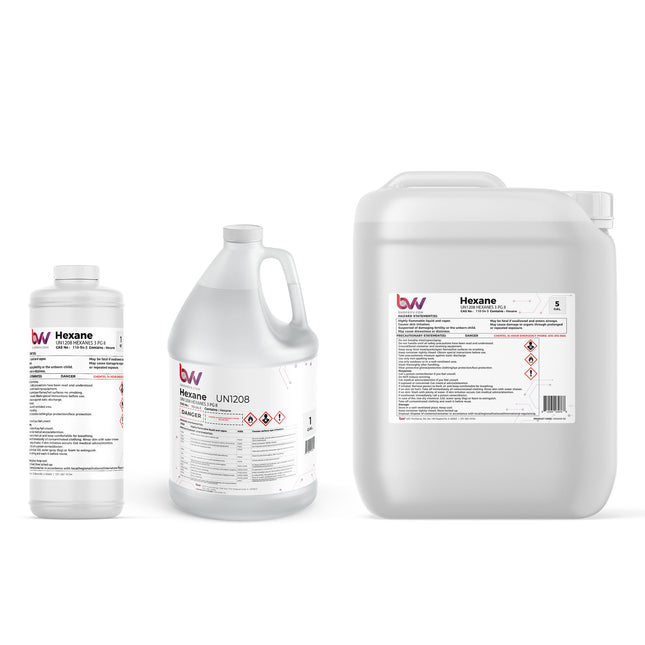
Hexane 99% Lab Grade
BVV™ High Purity Lab Grade Hexane (Note: Container style and color may vary) BVV™ High Purity Lab Grade Hexane is a perfect solution for cleaning up and clarifying the extracted material and removing the green colored plant material and some waxes out of the product to produce a cleaner end result when distilling extracts. Chemical Formula: C6H14 Molecular Weight: 86.178 g·mol−1 CAS Registry Number: 110-54-3 Appearance Colorless Liquid Odor: Petrolic Density 0.6606 g mL−1 Boiling Point: 68.5 °C / 155.2 °F Solubility in water: 9.5 mg L−1 GHS Pictograms: GHS Signal Word: Danger GHS Hazard Statements: H225, H302, H305, H315, H336, H361fd, H373, H411 GHS Precautionary Statements P201, P202, P210, P233, P235, P240, P241, P242, P243, P260, P264, P271, P273, P280, P281, P301+P330+P331, P302+P352, P303+P361+P353, P304+P340, P308+P313, P310, P312, P314, P332+P313, P363, P370+P378, P391, P403+P233, P405, P501 UN Identification Number: 1208 Proper Shipping Name: Hexanes Transport Hazard Class: 3 Packing Group: II DOT Placard: What Is Hexane? Hexane is a hydrocarbon compound with the chemical formula C6H14. It is a colorless, flammable liquid that is commonly used as a solvent in various industrial processes. Hexane is composed of six carbon atoms and 14 hydrogen atoms and belongs to a class of compounds known as alkanes. What Is Hexane Used For? Hexane is a versatile chemical compound primarily used as a solvent in various industrial applications. Its main uses include: Oil Extraction: Hexane is commonly used in the food industry to extract vegetable oils from seeds and other plant materials, such as soybeans, sunflower seeds, and peanuts. It dissolves the oils, leaving behind the solid plant material. The extracted oils are used in cooking, food processing, and as ingredients in various products. Laboratory and Chemical Processes: Hexane is used as a solvent in laboratories for a wide range of chemical reactions, extractions, and chromatography procedures. It is particularly useful for processes that require a non-polar solvent. Industrial Cleaning: Hexane's strong solvent properties make it effective for cleaning and degreasing industrial machinery, equipment, and parts. It is often used in maintenance and manufacturing settings to remove oils, greases, and other contaminants. Adhesive Manufacturing: Hexane is used in the production of adhesives, including those used in the shoe and leather goods industry. It helps dissolve and disperse adhesive components. Paints and Coatings: In the paint and coatings industry, hexane can be found in some formulations, especially in solvent-based paint systems. It can help adjust the viscosity and improve the application properties of coatings. Nail Polish Remover: Some nail polish removers contain hexane as a solvent to help dissolve and remove nail polish quickly and effectively. Hexane as a Fuel: While not a major use, hexane can be used as a fuel in some internal combustion engines. However, this application is less common than its use as a solvent. It's important to note that hexane is flammable and can pose health risks if not handled properly. Exposure to hexane vapor should be minimized, and safety precautions, such as proper ventilation and the use of personal protective equipment, should be followed when working with this chemical. What Is The Structure of Hexane? Hexane is an organic compound with the molecular formula C6H14. It belongs to the class of hydrocarbons known as alkanes, which are characterized by single bonds between carbon atoms. Hexane specifically has a linear or straight-chain structure, meaning that its carbon atoms are arranged in a continuous chain. The structural formula of hexane is as follows: In this structural formula, each "C" represents a carbon atom, and each "H" represents a hydrogen atom. Hexane has six carbon atoms and 14 hydrogen atoms, consistent with its molecular formula (C6H14). The carbon-carbon bonds in hexane are all single bonds, resulting in a saturated hydrocarbon structure. This linear arrangement of carbon atoms is a characteristic feature of straight-chain alkanes. How Is Hexane Produced? Hexane is typically produced from the refining of crude oil, and its production involves several steps, including distillation and fractionation. Here is an overview of the process: Crude Oil Refining: Hexane is derived from the hydrocarbon fraction of crude oil. Crude oil is first refined in a petroleum refinery to separate it into various fractions based on boiling points. Hexane is obtained from one of these fractions, usually the naphtha or distillate fractions, which contain hydrocarbons with six carbon atoms. Distillation: The selected fraction from the crude oil is subjected to a distillation process to separate it further into its constituent hydrocarbons based on their boiling points. Hexane is separated from other hydrocarbons with similar boiling points during this step. Fractionation: After distillation, the fraction containing hexane is further fractionated to isolate pure hexane. Fractionation involves additional distillation steps to separate hexane from any remaining impurities or hydrocarbons with different carbon chain lengths. Purification: To ensure the final product is of high purity, the hexane is subjected to purification processes, such as solvent extraction or adsorption, to remove any remaining impurities, including sulfur compounds and aromatics. Quality Control: The purified hexane undergoes rigorous quality control testing to ensure it meets industry and regulatory standards. This includes testing for purity, composition, and the absence of contaminants. Packaging: The final purified hexane is typically packaged and stored for distribution to various industries and applications. It's important to note that there are different isomers of hexane, including n-hexane, which is a straight-chain hexane, and various branched-chain isomers (isohexanes). The specific isomer produced and its purity level can vary based on the intended use of the hexane. For industrial and laboratory use, high-purity n-hexane is often preferred. The production of hexane is an important part of the petrochemical industry, as it serves as a solvent in various applications, including extraction, cleaning, and as a carrier for certain industrial processes. What Are The Hazards of Hexane? Hexane is a chemical solvent that poses several health and safety hazards. It's essential to handle hexane with care and be aware of its potential risks. Here are some of the hazards associated with hexane exposure: Inhalation Hazard: Hexane vapors can be harmful when inhaled. Breathing in high concentrations of hexane vapor may lead to symptoms such as dizziness, headache, nausea, eye and throat irritation, and in severe cases, unconsciousness. Nervous System Effects: Prolonged exposure to hexane, particularly n-hexane (a common isomer of hexane), can damage the nervous system. This condition is known as "hexane neuropathy" or "peripheral neuropathy." It may cause numbness, tingling, muscle weakness, and coordination problems in the hands and feet. Skin Irritation: Hexane can irritate the skin upon direct contact. Prolonged skin exposure or contact with hexane-containing solutions can lead to skin dryness, redness, and irritation. Eye Irritation: Contact with hexane may cause eye irritation, including redness, tearing, and discomfort. Flammability: Hexane is highly flammable and can form explosive mixtures with air. It should be stored away from open flames, sparks, and heat sources. Environmental Impact: Spills or releases of hexane into the environment can have adverse effects on aquatic life and ecosystems. Hexane is not easily biodegradable and can persist in the environment. Chronic Health Effects: Long-term exposure to hexane may lead to chronic health effects, particularly neurological damage. Workers who are regularly exposed to hexane, such as in industrial settings, should take precautions to minimize exposure. Carcinogenicity: Some studies suggest that n-hexane may have carcinogenic potential, although the evidence is not conclusive. It is classified as a Group 3 carcinogen by the International Agency for Research on Cancer (IARC), which means it is not classifiable as to its carcinogenicity to humans due to inadequate evidence. To minimize the risks associated with hexane, it is crucial to follow safety guidelines and use appropriate personal protective equipment (PPE) when working with hexane-containing products. Proper ventilation, such as using fume hoods or working in well-ventilated areas, can help reduce inhalation exposure. Additionally, employers should provide training to employees on the safe handling and storage of hexane, along with emergency response procedures in case of spills or accidents. How Do I Use Hexane Safely? Using hexane safely requires following proper safety precautions and guidelines to minimize the risks associated with this chemical solvent. Here are some safety tips for handling hexane safely: Use Adequate Ventilation: Always work with hexane in well-ventilated areas, such as a fume hood or with proper exhaust systems. Adequate ventilation helps to reduce exposure to hexane vapors. Wear Protective Gear: When working with hexane, wear appropriate personal protective equipment (PPE), including safety goggles, lab coats, chemical-resistant gloves, and closed-toe shoes. The specific PPE requirements may vary based on the task and the concentration of hexane being used. Avoid Skin Contact: Prevent skin contact with hexane by wearing chemical-resistant gloves and long-sleeved clothing. In case of skin contact, wash the affected area with plenty of water and soap. Seek medical attention if irritation persists. Prevent Eye Contact: Protect your eyes with safety goggles or a face shield. In case of eye contact, flush the eyes with clean, lukewarm water for at least 15 minutes and seek immediate medical attention. No Eating, Drinking, or Smoking: Do not eat, drink, or smoke while working with hexane or in areas where hexane is used. Contaminated hands or surfaces can transfer hexane to the mouth, leading to ingestion. Handle in Controlled Environment: Perform tasks involving hexane in a controlled environment away from open flames, sparks, heat sources, and ignition sources. Hexane is highly flammable and can form explosive mixtures with air. Label Containers: Ensure that containers holding hexane are properly labeled with appropriate hazard warnings and information. Store Properly: Store hexane containers in a cool, dry, well-ventilated area away from incompatible substances. Keep containers tightly sealed when not in use. Use Minimal Amounts: Use the smallest amount of hexane necessary to complete your task. Minimizing the quantity of hexane used reduces potential exposure. Emergency Equipment: Have access to emergency equipment, such as eye wash stations and safety showers, in case of accidental exposure. Know the location of fire extinguishers and fire alarm systems. Training: Ensure that personnel working with hexane are trained in its safe handling, storage, and disposal. Training should cover hazard recognition, first aid procedures, and emergency response protocols. Spill Response: In case of a hexane spill, follow your organization's spill response procedures. This may include containing the spill, using absorbent materials to soak up the liquid, and disposing of contaminated materials properly. Dispose of Hexane Waste Properly: Dispose of hexane waste in accordance with local, state, and federal regulations. Hexane waste should be collected and disposed of as hazardous waste. Regular Maintenance: Inspect equipment and storage containers regularly to ensure they are in good condition and free from leaks or damage. Medical Monitoring: If workers are regularly exposed to hexane, consider implementing a medical monitoring program to track their health and detect early signs of exposure-related issues. It's essential to familiarize yourself with the specific safety guidelines and procedures established by your organization or regulatory authorities when working with hexane, as they may vary depending on the application and concentration of hexane being used. Always prioritize safety and take appropriate precautions to protect yourself and others from potential hazards associated with hexane. Hexane Safety Data Sheet (SDS) Hexane Certificate of Analysis (COA)
$25.24 - $687.07
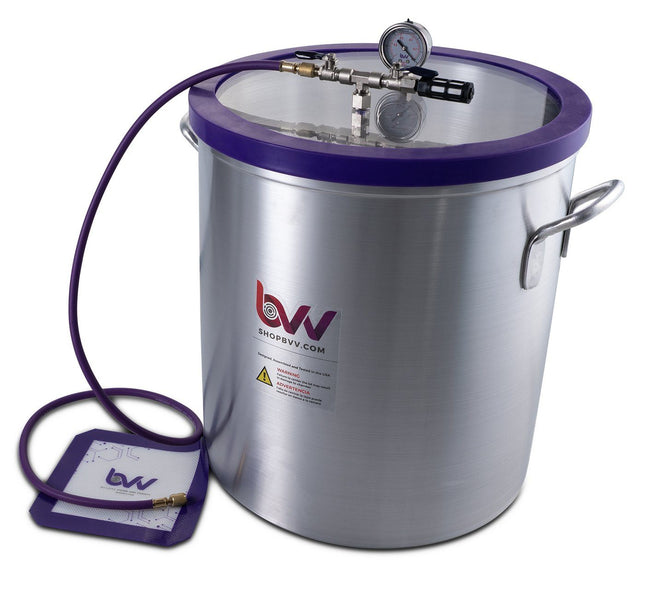
Best Value Vacs 15 Gallon Aluminum Vacuum Chamber
15 Gallon Vacuum & Degassing Chamber (Comes with 2 yr Limited Warranty) This is a complete BestValueVac® vacuum chamber setup designed built and 100% tested in Naperville, Illinois. With our unique patent pending gasket design (Patent #9475627) this chamber is sure to last 10,000 uses with proper care and maintenance. The gasket itself is reversible (doubling the life of our system) allowing customers to instantly take it off and flip it over. No adhesives are used! The maximum allowed temperature of this chamber is 160f. The components of this chamber are rated at higher temperatures however as a vacuum vessel we limit maximum operational temperature to 160f. Every chamber is tested prior to shipping to lose no more than 2.5Hg/24hrs. -Please refer to these charts for vacuum specifications at altitude and conversions: Vacuum at Altitude Chart Vacuum Conversion Chart Key Features: Aluminum Vessel Highly Durable and Reversible Silicone Gasket Glycerin filled vacuum gauge User friendly vacuum connections that fit most vacuum pumps on the market 50 Micron Air filter for reducing airborne contaminants when releasing the vacuum Silicone vacuum pad 5' of vacuum rated HVAC hose to pull a vacuum. Specifications Chamber Material 3004 Aluminum Gasket Material Silicone Lid Material Acrylic Internal Dimensions (ID) 17.2" Tall x 16-1/8" Diameter Vacuum Gauge (Glycerin Filled) InHG (0)-(-30) Manifold Connections 1/4" SAE and 1/4" FNPT Temperature Rating 150°F (65°C) Additional Included Items 5' Purple Vacuum Rated HVAC Hose Platinum Cured Silicone Pad Black 50 Micron Air Filter Compatibility Explanation: BestValueVac® Chambers are not compatible with stabilization resin (i.e. Cactus Juice™, Gator Venom™, Minwax™ etc.), alcohol, ethanol, acetone and acrylic based monomers or polymers.The lid may only be cleaned with soapy water. ShatterVac® chambers are not compatible with stabilization resin (i.e. Cactus Juice™, Gator Venom™, Minwax™ etc.), acetone, acrylic based monomers or polymers. The lid may be cleaned with soapy water and low strength cleaning agents. GlassVac® chambers are compatible with all solvents and stabilization resins. We only recommend and warranty GlassVac® chambers for resin infusion and wood stabilization.The lid may be cleaned with any solvent or cleaning agent. See FAQ at the top for product safety warnings. Pump Warranty Information: Customers using solvents such as stabilization resins (MinWax™, Gator Venom™ etc.), alcohol and other polar solvents must use the vacuum pumps in conjunction with a cold trap for evacuations in excess of 5 minutes. (Exludes Cactus Juice™) f the consumer is using the pump for prolonged periods of time exceeding 5 minutes we require that a cold trap is used or the pump warranty is void. These stabilization resins have the ability to break down the internal components of the pump that are plastic resulting in a seized motor voiding all warranties. When evacuation exceeds 5 minutes these solvents begin to vaporize and then re-condense in the vacuum pump reservoir. Once enough solvent re-condenses in the pump displacing the oil the plastic internal components may begin to warp, melt or seize. The use of a cold trap will condense the vapors prior to making their way to the vacuum pump preventing pump damage due to excessive use. Furthermore, Minwax Wood Hardener™ is not to be used with any vacuum pumps, EVER. (A seized motor will result within the first use.) To prevent these issues from happening to your process, change the Oil after each vacuum pump use, Even if the use time is only 5min. For shipping info including Import/Export details visit our Shipping link at the bottom of the page.
$500.58
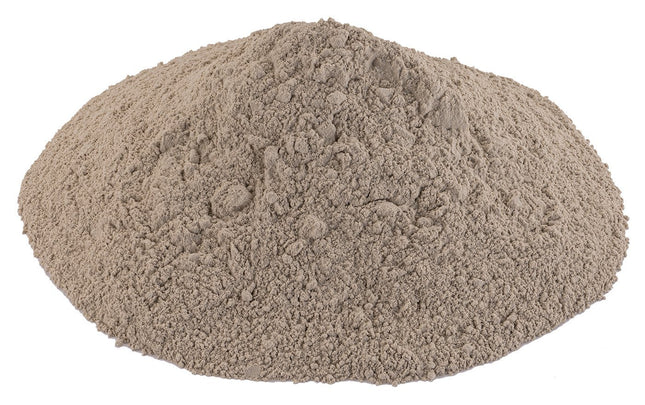
Pure-Flo® B81 Supreme Activated Bleaching & Decolorizing Bentonite for Edible Oils *FDA-GRAS (Compares to T-5™)
Pure-Flo® B81 Supreme Moderately Activated Bentonite Clay for Bleaching & Decolorizing Edible Oils pH:4.4 Pure-Flo® B81 Supreme Offers fats and oils processors surface modified performance at the best value. Excellent for oils with moderate color and chlorophyll levels. Supreme B81 adsorbent has been activated using a proprietary Surface Modification Technology (SMT). Pure-Flo® Supreme B81 Data Sheet.pdf B81 Supreme Safety Data Sheet • Excellent metals adsorption characteristics (P, Ca, Fe, Mg, Ni, etc.)• Removes color bodies from a variety of oils and effectively eliminates chlorophyll from vegetable oils• Removes soaps and phospholipids• Minimizes free fatty acid rise during bleaching• Outstanding filtration characteristics, including long filtration cycles and lesspressure build up at cycle end ph:4.4 FDA GRAS (Generally Recognized as Safe) - This product is safe for processing food, as long as its not part of the end product being consumed. NSF- HACCP *Prior to down packing this product was certified Kosher & Hallal. It does not retain its certifications after down packing, Sorry BVV™ doesn't have an on staff Rabbi or Imam on site to re-establish those certifications. Note: Bulk Bags and Bulk sizes are non-stocked items and will be ordered as needed and carry a several weeks lead time and require a forklift or pallet jack
$28.04 - $3,154.91
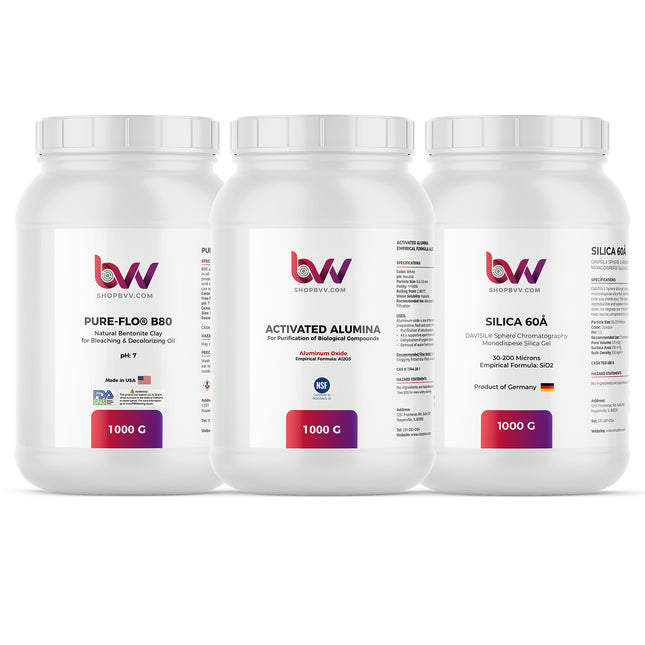
BVV™ Filtration Media CRC Starter Bundle
BVV™ Filtration Media CRC Starter Bundle This is the BVV recommended starter bundle for anyone venturing in to closed loop Color Remediation and desiring to make a clear and cleaner end product. This bundle works well with any of our Inline CRC hardware kits. (Seen here: ICRC300) BVV recommends a Pressure Flow through this bundle @ 30PSI. What's Included in the Bundle? BVV™ Silica Gel 60A - BVV™ Chromatographic Silica Gel is as premium as it gets. We recommend this for our Top layer of the CRC to grab fats, waxes and color bodies. It wont take the place of full dewaxing but it does a darn good job on its own. We recommend 30-50g of Silica per lb. biomass as the top layer of your filtration stack depending on the age of your material and the diameter of your filtration column. Pure-Flo® B80 Natural Bentonite for Bleaching - Pure-Flo® B80 will remove chlorophyll, color bodies, fats, waxes. Its natural neutral pH will help retain terpene flavonoids and clarify and remove dark colors from your oils. B80 is the most commonly used CRC media in extraction. We recommend you use 100g of bentonite Clay per lb. biomass above a layer of Activated Alumina. BVV™ Activated Alumina - BVV™ Activated Alumina is granular media excellent for grabbing water and waxes. We recommend Activated Alumina as the bottom layer of your filtration stack to absorb moisture at 30-50g per lb. biomass depending on the diameter of your filtration column.
$103.76 - $225.75
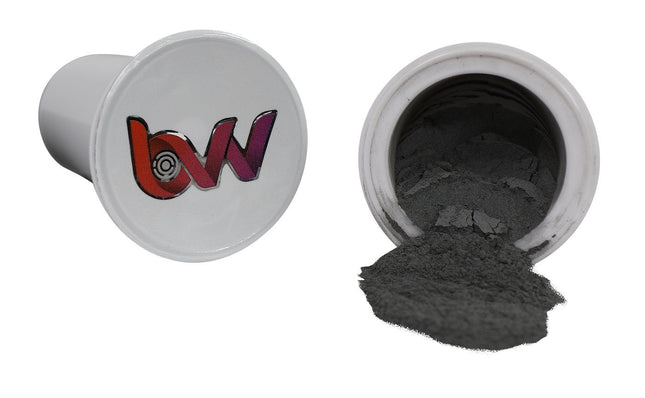
AFS Disposable Color Bleach / B80 Cartridge *FDA Certified Material
AFS Disposable Color Bleach Cartridge Note: Stainless Steel filter housing sold separately. (Click Here for Housing) AFS Instruction Manual Download Here AFS Filters are the first and only disposable color remediation filter cartridges for the botanical extraction industry. The Patent Pending design allows for an easy to use solution implemented into existing extraction systems; and is now available as a standard integration from many equipment manufacturers. AFS Filters are a simple solution that allows for the use of prepackaged filters, which are available in different recipes depending on the application. With the integrated 2.5µm paper filter molded and sealed into the cup there is no media leak through. Pre-packed means there's no need to be an expert in remediation filter media and how to construct filters; as well as eliminates the messy process of building/packing filters yourself. Disposable offers no need for cleaning the filter housings afterwards and trying to un-clog stainless filter screens. Less R&D investment, less mess, and less down time allows for higher throughput and more profit. The media contained in the BVV™ Color Bleach filter cartridge is a low pH Pure-Flo® Perform 6000 bentonite clay in a 10:1 ratio of BVV™ T-1 Activated Hardwood Carbon. Using only made in the USA materials that are FDA-GRAS and NSF certified. *The results show are using the same material for each extraction. Butane only method vs. BVV™ color bleach (110g filled Cartridge) Light Filtration is the trimmed down version of the standard Medium filter. These are best suited for extractions using fresh high end input materials that only needs a light cleaning. Medium Filtration is our standard go-to filter. This is the most commonly used and sold filter. It's great for general filtration and lightening of extracted products. Heavy Filtration is packed with the highest amount of active extraction media. These filters are best suited for exceptionally dark extractions or for extractions with normal input materials where the desired outcome is closer to clear. Heavy filters offer the highest level of filtration. Technical Specifications: Life Span: 1 Time use, Good for 5-7 lbs. of dry material. Temperature Rating: -40°C-70°C Top Seal: Induction Sealed (No glue is used) Filter: Cellulose Paper Pressure Rating: Recommended 60psi, Paper will hold 80-90 psi Max. Media: Low pH bentonite clay in a 10:1 ratio of activated 100% hardwood carbon, USA Made Materials and Certificates of Analysis available. Shell Material: Polypropylene Excellent compatibility and Safe for chemicals in our industry (Butane, Propane, Ethanol). Pressure Method: Nitrogen Assist, unless you open blast CRC. Then you can assist with an air compressor. AFS Cup weight: 48g Media Fill Volume: 110-120g Recommend Minimum Biomass: 1lb (lesser biomass will see drastic yield losses) AFS Safety Data Sheets *Please recycle your spent Cartridges. *Yield losses under refinement are to be expected but overall potency will be retained and will proportionally increase.
$77.12 - $879.17
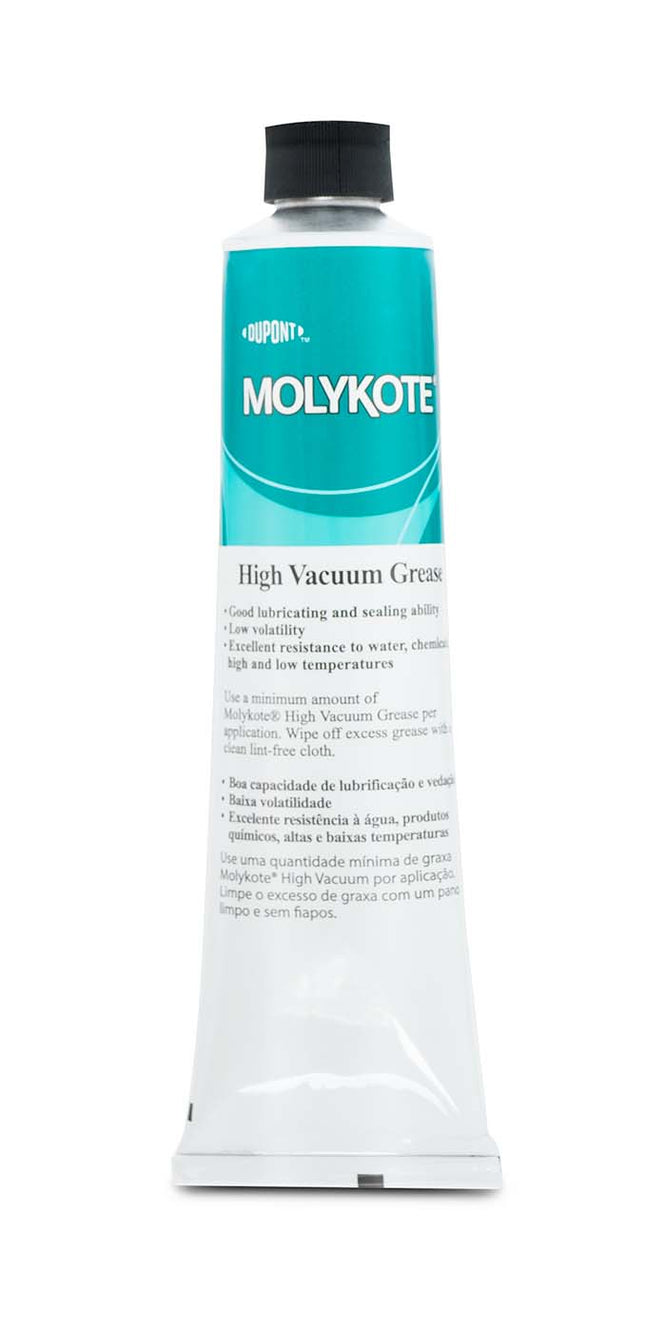
MOLYKOTE® High Vacuum Grease 150g
Key Properties: NLGI Grade 3-4, translucent white, used primarily in sealing vacuum and pressure systems. Molykote Technical Data Sheet Molykote Safety Data Sheet Applications: Seals and lubricates chemical processing equipment. Lubricating plug valves, control valves, flow meter bearings, ceramic plug cocks, fire extinguisher valves, water treating equipment, synthetic rubber gaskets and seals in high-temperature applications. Sealing vacuum and pressure systems. Lubricating O-rings in binoculars and telescopes; prevents fogging of delicate lenses. Performance Benefits: Reduces wear in plastic-to-metal and rubber-to-metal contact Low volatility Excellent resistance to water, chemicals, and high and low temperatures Meets requirements of FDA 21 CFR 175.300 Good chemical resistance Good oxidation resistance Good plastic & rubber compatibility Good water resistance High tack & adhesion High temperature performance Low temperature performance Wide temperature range Product Details: Product type: Compounds Technology: Silicone NLGI Grade: 3-4 Thickener: Silica Low Temp: (C) -40 High Temp: (C) 204 Color Translucent: White
$54.69
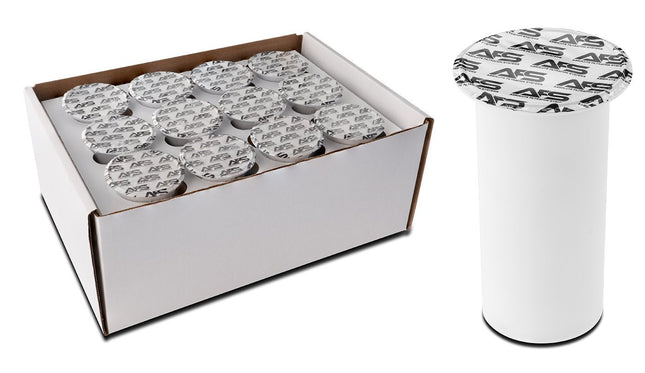
AFS 2.5" Disposable Color Remediation Cartridge
AFS Disposable Color Remediation Cartridge Note: Stainless Steel filter housing sold separately. (Click Here for Housing) AFS Instruction Manual Download Here AFS Filters are the first and only disposable color remediation filter cartridges for the botanical extraction industry. Our Patent Pending design allows for an easy to use solution implemented into existing extraction systems and is now available as a standard integration from many equipment manufacturers. AFS Filters are a simple solution that allows for the use of prepackaged filters, which are available in different recipes depending on the application. With the integrated 2.5µm paper filter molded and sealed into the cup, there is no media leak through. Pre-packed means there's no need to be an expert in remediation filter media and how to construct filters; as well as eliminates the messy process of building/packing filters yourself. Disposable offers no need for cleaning the filter housings afterward and trying to un-clog stainless filter screens. Less R&D investment, less mess, and less downtime allows for higher throughput and more profit. These come in light, medium, and heavy filtration. Learn more about each: Light Filtration is the trimmed down version of the standard Medium filter. These are best suited for extractions using fresh high-end input materials that only needs a light cleaning. Medium Filtration is our standard go-to filter. This is the most commonly used and sold filter AFS offers.. It's great for general filtration and lightening of extracted products. Heavy Filtration is packed with the highest amount of active extraction media. These filters are best suited for exceptionally dark extractions or for extractions with normal input materials where the desired outcome is closer to clear. Heavy filters offer the highest level of filtration. Technical Specifications: Life Span: 1 Time use, 5-7 lbs. of dry material. Temperature Rating: -40°C-70°C Top Seal: Induction Sealed (No glue is used) Filter: Cellulose Paper Pressure Rating: Recommended 60psi, Paper will hold 80-90 psi Max. Media: Proprietary licensed recipe. Shell Material: Polypropylene Excellent compatibility and Safe for chemicals in our industry (Butane, Propane, Ethanol). Pressure Method: Nitrogen Assist, unless you open blast CRC. Then you can assist with an air compressor. Click here to see SDS Sheet *Please recycle your spent Cartridges.
$58.89 - $740.35
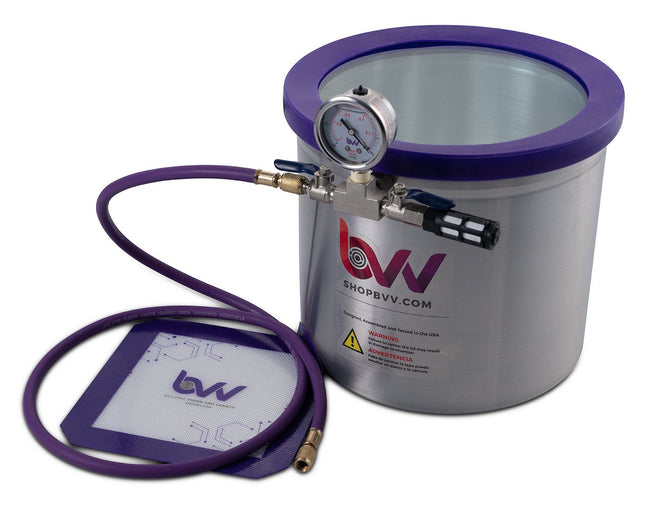
Glass Vac 5 Gallon Aluminum Vacuum Chamber
5 Gallon Vacuum Chamber (Comes with 2 year Limited Warranty) This is a complete BestValueVac® vacuum chamber setup designed built and 100% tested in Naperville, Illinois. With our unique patent pending gasket design (Utility Patent #9475627) this chamber is sure to last 10,000 uses with proper care and maintenance. The gasket itself is reversible (doubling the life of our system) allowing customers to instantly take it off and flip it over. Every chamber is tested prior to shipping to lose no more than 2.5Hg/24hrs. Glass Vac Vacuum Chambers are ideal for wood workers using the wood stabilization process because the glass lid will not deteriorate like acrylic or polycarbonate lids. -Please Refer to these charts for vacuum specifications at altitude and conversions: Vacuum at Altitude Chart Vacuum Conversion Chart Key Features: Aluminum Vessel Highly Durable and Reversible Silicone Gasket Glycerin filled vacuum gauge User friendly vacuum connections that fit most vacuum pumps on the market 50 Micron Air filter for reducing airborne contaminants when releasing the vacuum Silicone vacuum pad 5' of vacuum rated HVAC hose to pull a vacuum. Specifications Chamber Material 3004 Aluminum Gasket Material Silicone Lid Material Glass Internal Dimensions (ID) 10" Tall x 12" Diameter Vacuum Gauge (Glycerin Filled) InHG (0)-(-30) Manifold Connections 1/4" SAE and 1/4" FNPT Temperature Rating 150°F (65°C) Additional Included Items 5' Purple Vacuum Rated HVAC Hose Platinum Cured Silicone Pad Black 50 Micron Air Filter Compatibility Explanation: BestValueVac® Chambers are not compatible with stabilization resin (i.e. Cactus Juice™, Gator Venom™, Minwax™ etc.), alcohol, ethanol, acetone and acrylic based monomers or polymers.The lid may only be cleaned with soapy water. ShatterVac® chambers are not compatible with stabilization resin (i.e. Cactus Juice™, Gator Venom™, Minwax™ etc.), acetone, acrylic based monomers or polymers. The lid may be cleaned with soapy water and low strength cleaning agents. GlassVac® chambers are compatible with all solvents and stabilization resins. We only recommend and warranty GlassVac® chambers for resin infusion and wood stabilization.The lid may be cleaned with any solvent or cleaning agent. See FAQ at the top for product safety warnings. Pump Warranty Information: Customers using solvents such as stabilization resins (MinWax™, Gator Venom™ etc.), alcohol and other polar solvents must use the vacuum pumps in conjunction with a cold trap for evacuations in excess of 5 minutes. (Exludes Cactus Juice™) If the consumer is using the pump for prolonged periods of time exceeding 5 minutes we require that a cold trap is used or the pump warranty is void. These stabilization resins have the ability to break down the internal components of the pump that are plastic resulting in a seized motor voiding all warranties. When evacuation exceeds 5 minutes these solvents begin to vaporize and then re-condense in the vacuum pump reservoir. Once enough solvent re-condenses in the pump displacing the oil the plastic internal components may begin to warp, melt or seize. The use of a cold trap will condense the vapors prior to making their way to the vacuum pump preventing pump damage due to excessive use. Furthermore, Minwax Wood Hardener™ is not to be used with any vacuum pumps, EVER. (A seized motor will result within the first use.) To prevent these issues from happening to your process, change the Oil after each vacuum pump use, Even if the use time is only 5min. For shipping info including Import/Export details visit our Shipping link at the bottom of the page.
$326.71
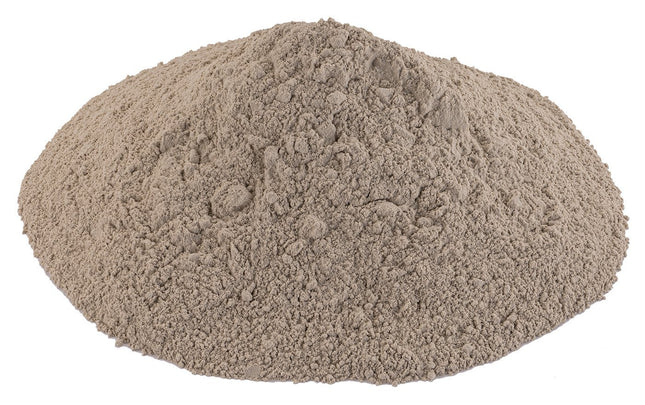
Perform 6000 Highly Activated Bleaching & Decolorizing Bentonite
Highly Activated Bentonite Clay for Bleaching & Decolorizing Edible Oils pH: 2.5 Pure-Flo® Perform 6000 is a highly activated bentonite clay that is used to purify extremely difficult to bleach oils with the most challenging levels of chlorophyll and color bodies. Particle Size: 325 Mesh Color: Beige Performance Features & Benefits: Filter Aid Removes phosolipids Excellent Metal adsorption (P, Ca, Fe, Mg, etc.) Effective with all types of difficult-to-bleach oil Top chlorophyll removal in its class & improved red color reduction pH 2.5 FDA GRAS (Generally Recognized as Safe) - This product is safe for processing food, as long as its not part of the end product being consumed. Pure-Flo® Perform 6000 Data Sheet.pdf Pure-Flo® Perform 6000 Safety Data Sheet (SDS).pdf Note: Bulk Bags and Bulk sizes are non-stocked items and will be ordered as needed and carry a several weeks lead time and require a forklift or pallet jack Note: Container style and color may vary. Product is sold by weight which may result in container not being full.
$28.04 - $3,260.07
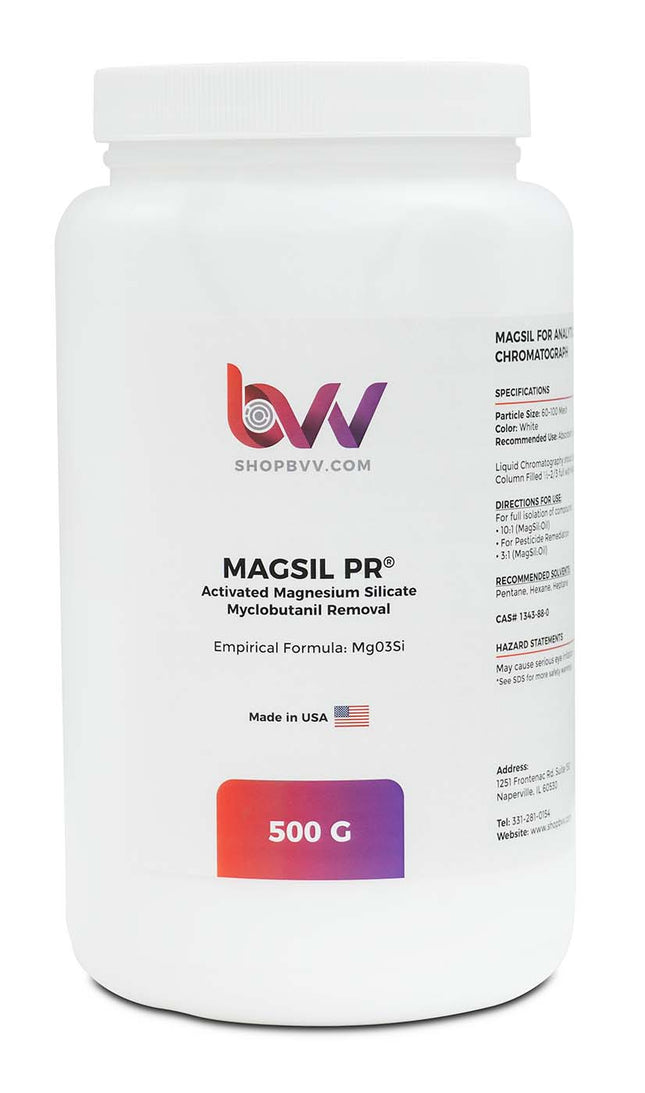
MagSil-PR® Adsorbent for Chromatography
MagSil-PR® Adsorbent for Chromatography BVV™ MagSil-PR® Adsorbent for Chromatography is an adsorbent for the separation of lipids and is a commercially prepared magnesia-silica gel. MagSil-PR® has a coarse mesh size which helps with rapid flow rate for column chromatography. It's main benefit is pesticide removal from extracted plant material and will dramatically improve the color and clarity of the material. It also has the provided benefit to bind to polar water-soluble compounds which can be filtered out through a 20-micron mesh screen. Particle Mesh Size: 60/100 BVV™ MagSil-PR® SDS
$207.52 - $2,629.09
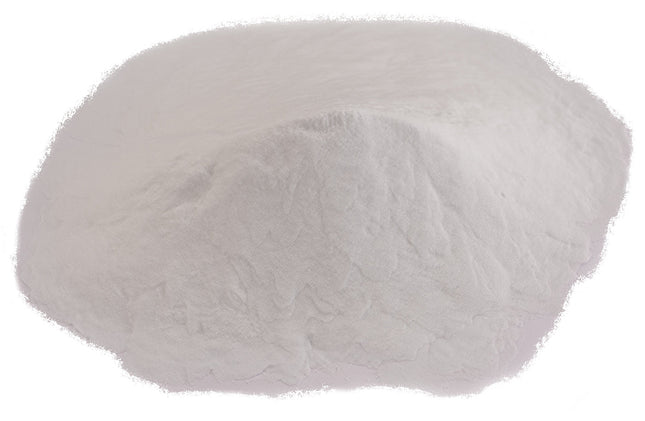
CANA-SIL60™ Silica Gel 60A Chromatographic Grade 40-63 micron (230-400 Mesh)
CANA-SIL60™ Silica Gel Silicon Dioxide 60A Chromatographic, Extraction CRC Grade Cana-Sil™ is an Optimized silica gel for extractions. This powdered silica gel (silicon dioxide) for use in chromatography batch extractions and decolorizations. Cana-Sil60 can also be used as a general adsorbent for impurities. Optimized particle size, surface area, pH, and purity make it a particularly useful material for the separation of small molecules, peptides, lipids, alkaloids, and a variety of other compounds. Silica Gel is particularly useful to use layered on top of your bentonite to remove plant gums and waxes. CANA-SIL60 Technical Data Sheet CANA-SIL60 Safety Data Sheet CANA-SIL60 Certificate of Analysis Key Specs: Particle Size: 40-63 Micron (230-400 Mesh) Pore Volume: 0.6-0.8 mL/g Loss on Drying: ≤ 2.0 wt% pH: 6.5-7.5 Empirical Formula: SiO2 Use: Chromatography Purification Hazard Statement: No ingredients are hazardous according to OSHA criteria CAS# 112926-00-8
$39.26 - $11,042.18
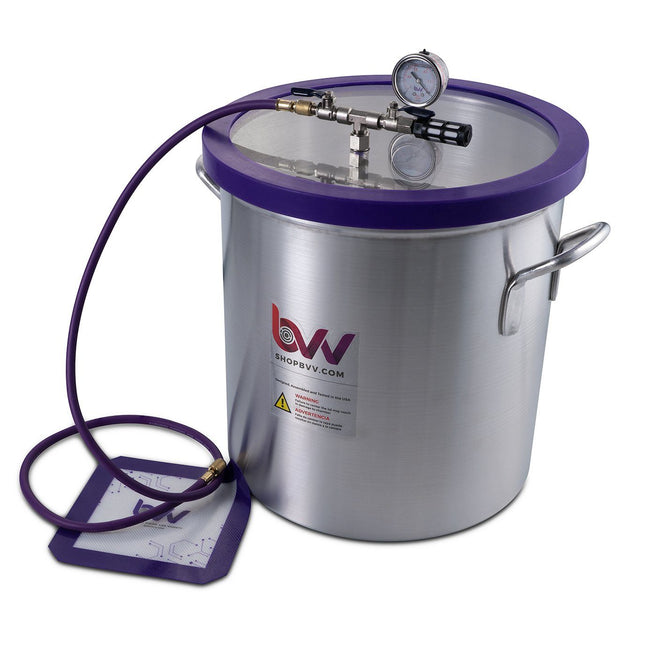
Best Value Vacs 10 Gallon Aluminum Vacuum Chamber
10 Gallon Shatter Vac Vacuum & Degassing Chamber Comes with 2 yr Limited Warranty This is a complete BestValueVac® vacuum chamber setup designed, built and 100% tested in Naperville, Illinois. With our unique patented gasket design (Patent #9475627) this chamber is sure to last 10,000 uses with proper care and maintenance. The gasket itself is reversible (doubling the life of our system) allowing customers to instantly take it off and flip it over. Every chamber is tested prior to shipping to lose no more than 2.5”Hg/24hrs. Our premium Vac Vacuum & Degassing Chamber is a rigid enclosure that effectively works to remove entrapped air and other gases that could induce failure in the final product. Due to its low-pressure environment and solid vacuum design, this heavy-duty chamber can be used in a variety of vacuum applications. -Please refer to these charts for vacuum specifications at altitude and conversions: Vacuum at Altitude Chart Vacuum Conversion Chart key Features: Aluminum Vessel Highly Durable and Reversible Silicone Gasket Glycerin filled vacuum gauge User-friendly vacuum connections that fit most vacuum pumps on the market 50 Micron Air filter for reducing airborne contaminants when releasing the vacuum Silicone vacuum pad 5' of vacuum rated HVAC hose to pull a vacuum. Specification Chamber Material 3004 Aluminum Gasket Material Silicone Lid Material Acrylic Internal Dimensions (ID) 15" Tall x 14" Diameter Vacuum Gauge (Glycerin Filled) InHG (0)-(-30) Manifold Connections 1/4" SAE and 1/4" FNPT Temperature Rating 150°F (65°C) Additional Included Items 5' Purple Vacuum Rated HVAC Hose Platinum Cured Silicone Pad Black 50 Micro Air Filter Compatibility Explanation: BestValueVac® Chambers are not compatible with stabilization resin (i.e. Cactus Juice™, Gator Venom™, Minwax™ etc.), alcohol, ethanol, acetone and acrylic based monomers or polymers.The lid may only be cleaned with soapy water. GlassVac® chambers are compatible with all solvents and stabilization resins. We only recommend and warranty GlassVac® chambers for resin infusion and wood stabilization.The lid may be cleaned with any solvent or cleaning agent. See FAQ at the top for product safety warnings. Pump Warranty Information: Customers using solvents such as stabilization resins (MinWax™, Gator Venom™ etc.), alcohol and other polar solvents must use the vacuum pumps in conjunction with a cold trap for evacuations in excess of 5 minutes. (Exludes Cactus Juice™) If the consumer is using the pump for prolonged periods of time exceeding 5 minutes we require that a cold trap is used or the pump warranty is void. These stabilization resins have the ability to break down the internal components of the pump that are plastic resulting in a seized motor voiding all warranties. When evacuation exceeds 5 minutes these solvents begin to vaporize and then re-condense in the vacuum pump reservoir. Once enough solvent re-condenses in the pump displacing the oil the plastic internal components may begin to warp, melt or seize. The use of a cold trap will condense the vapors prior to making their way to the vacuum pump preventing pump damage due to excessive use. Furthermore, Minwax Wood Hardener™ is not to be used with any vacuum pumps, EVER. (A seized motor will result within the first use.) To prevent these issues from happening to your process, change the Oil after each vacuum pump use, Even if the use time is only 5min. For shipping info including Import/Export details visit our Shipping link at the bottom of the page.
$420.65
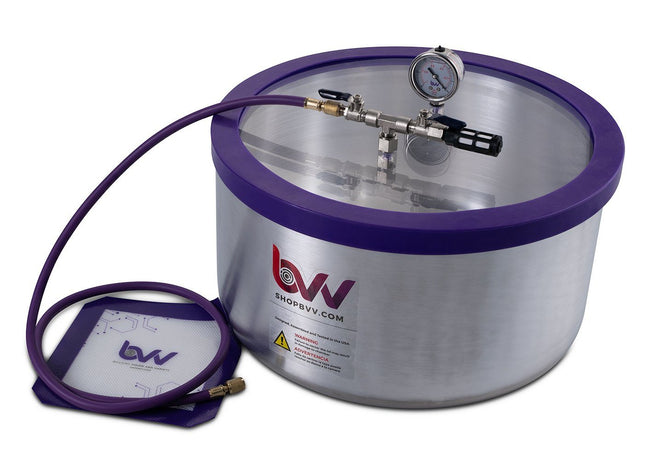
Best Value Vacs 7 Gallon Aluminum Vacuum Chamber
7 Gallon Vacuum & Degassing Chamber (Comes with 2 Year Limited Warranty) This is a complete BestValueVac® vacuum chamber setup designed built and 100% tested in Naperville, Illinois. With our unique patent pending gasket design (Patent #9475627) this chamber is sure to last 10,000 uses with proper care and maintenance. The gasket itself is reversible (doubling the life of our system) allowing customers to instantly take it off and flip it over. Every chamber is tested prior to shipping to lose no more than 2.5Hg/24hrs. -Please Refer to these charts for vacuum specifications at altitude and conversions: Vacuum at Altitude Chart Vacuum Conversion Chart Key Features: Aluminum Vessel Highly Durable and Reversible Silicone Gasket Glycerin filled vacuum gauge User friendly vacuum connections that fit most vacuum pumps on the market 50 Micron Air filter for reducing airborne contaminants when releasing the vacuum Silicone vacuum pad 5' of vacuum rated HVAC hose to pull a vacuum 3003 Grade Aluminum Body, lightweight and durable Precision lip edge at the top for the protection of silicone gasket Specification Chamber Material 3004 Aluminum Gasket Material Silicone Lid Material Acrylic Internal Dimensions (ID) 8" Tall x 16" Diameter Vacuum Gauge (Glycerin Filled) InHG (0)-(-30) Manifold Connections 1/4" SAE and 1/4" FNPT Temperature Rating 150°F (65°C) Additional Included Items 5' Purple Vacuum Rated HVAC Hose Platinum Cured Silicone Pad Black 50 Micro Air Filter Compatibility Explanation: BestValueVac® Chambers are not compatible with stabilization resin (i.e. Cactus Juice™, Gator Venom™, Minwax™ etc.), alcohol, ethanol, acetone and acrylic based monomers or polymers.The lid may only be cleaned with soapy water. ShatterVac® chambers are not compatible with stabilization resin (i.e. Cactus Juice™, Gator Venom™, Minwax™ etc.), acetone, acrylic based monomers or polymers. The lid may be cleaned with soapy water and low strength cleaning agents. GlassVac® chambers are compatible with all solvents and stabilization resins. We only recommend and warranty GlassVac® chambers for resin infusion and wood stabilization.The lid may be cleaned with any solvent or cleaning agent. See FAQ at the top for product safety warnings.
$392.61
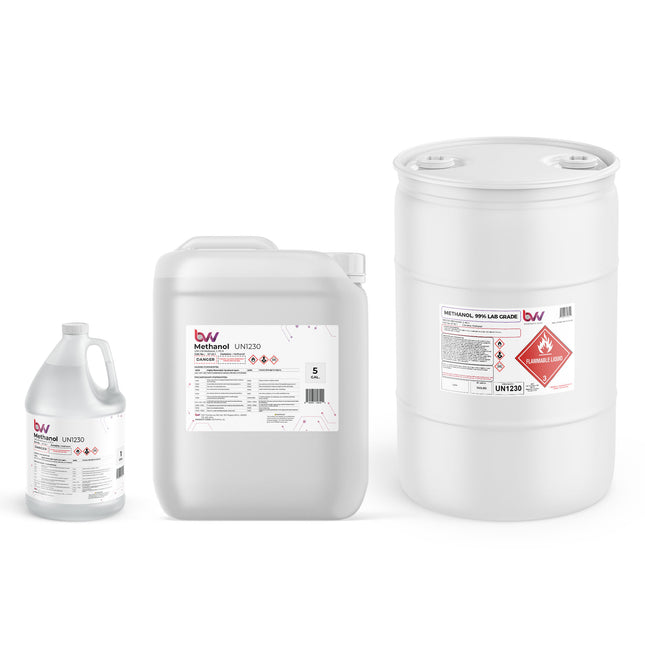
Methanol Lab Grade
High Purity Lab Grade Methanol BVV™ High Purity Lab Grade Methanol is used to remove and extract terpenes, tannins, alkaloids, glycosides, lignans, and terpinoids from plants. It is used to extract bio-active, phenolic and polar compounds from medicinal plants. Methanol is a high purity solvent used to manufacture botanical solutions and is easily evaporated. Methanol is used in research and testing laboratories for phytochemical study, phytochemical analysis and chemical synthesis. Methanol is used to prepare methanol/water/acetic acid mixtures. Chemical Formula: CH3OH Molecular Weight: 32.042 g·mol−1 CAS Registry Number: 67-56-1 Appearance Colorless Liquid Odor: Faint and similar to ethanol Density 0.792 g/cm3 Boiling Point: 64.7 °C /148.5 °F Solubility in water: Completely Soluble GHS Pictograms: GHS Signal Word: Danger GHS Hazard Statements: H225, H301, H302, H305, H311, H331, H370 GHS Precautionary Statements P210, P233, P235, P240, P241, P242, P243, P260, P264, P270, P271, P280, P301+P330+P331, P302+P352, P303+P361+P353, P304+P340, P305+P351+P338, P307+P311, P310, P311, P312, P337+P313, P361, P363, P370+P378, P403+P233, P405, P501 UN Identification Number: 1230 Proper Shipping Name: Methanol Transport Hazard Class: 3 Packing Group: II DOT Placard: What Is Methanol? Methanol, also known as methyl alcohol or wood alcohol, is a type of alcohol with the chemical formula CH3OH. It is the simplest alcohol, consisting of a methyl group (CH3) linked to a hydroxyl group (OH). Methanol is a colorless, flammable liquid with a slightly sweet odor. It is commonly used as an industrial solvent, antifreeze, fuel, and as a feedstock in the production of chemicals, plastics, and synthetic materials. Methanol can be synthesized from various sources, including natural gas, carbon monoxide, and biomass. It is considered a hazardous substance due to its toxicity when ingested, inhaled, or absorbed through the skin. Methanol is also used as an industrial and laboratory solvent and as a fuel in some types of racing cars and model engines. One important thing to note is that methanol is highly toxic when consumed, and even small amounts can be lethal. It should never be ingested, and safety precautions should be taken when handling this substance. What Is Methanol Used For? Methanol is used for a wide range of industrial, commercial, and laboratory applications. Some of its common uses include: Fuel: Methanol is used as an alternative fuel in some types of vehicles, particularly racing cars and model engines. It is also used in the production of biodiesel and as a fuel additive. Solvent: Methanol is a versatile solvent that can dissolve a variety of substances, making it useful in industries such as paint, varnish, and ink production. It is also used as a cleaning agent in laboratories and industrial settings. Antifreeze: Methanol is an essential component of some antifreeze formulations, where it helps prevent the freezing of engine coolant in cold temperatures. Chemical Intermediate: Methanol serves as a key building block in the production of various chemicals and materials, including formaldehyde, acetic acid, methyl methacrylate (used in plastics and coatings), and more. Fuel Cell Feedstock: Methanol can be used as a feedstock for the production of hydrogen, which can be used in fuel cells for electricity generation and other applications. Preservative: In the pharmaceutical and personal care industries, methanol is used as a preservative in some products. Denaturant: Methanol is added to industrial ethanol to make it unfit for consumption (denatured). This ensures that the ethanol cannot be used for drinking purposes and is used for industrial applications. Laboratory Reagent: Methanol is commonly used in laboratories as a reagent and solvent for various chemical experiments and analyses. Extraction: It is used in some extraction processes, such as the extraction of essential oils from plants. Energy Storage: Methanol is being explored as a potential energy carrier for energy storage and transportation, particularly in the form of methanol fuel cells. It's important to note that methanol is toxic to humans and should be handled with care. Ingesting or inhaling methanol vapors can be extremely dangerous and potentially fatal. Proper safety precautions and handling procedures are necessary when working with methanol. What Is The Structure of Methanol? Methanol, also known as methyl alcohol, has a simple chemical structure. Its molecular formula is CH3OH, which represents one carbon (C) atom, four hydrogen (H) atoms, and one oxygen (O) atom bonded together. Here's the structural formula of methanol: In this structure: The central carbon atom (C) is bonded to three hydrogen atoms (H) and one oxygen atom (O). The oxygen atom is bonded to the carbon atom through a single covalent bond (C-O). The remaining three hydrogen atoms are bonded to the carbon atom, completing its four covalent bonds. Methanol is a polar molecule due to the electronegativity difference between oxygen and hydrogen atoms, which results in a partial positive charge on the hydrogen atoms and a partial negative charge on the oxygen atom. This polarity gives methanol its unique chemical properties and makes it a versatile solvent in various applications. What are the Hazards of Methanol? Methanol, while commonly used in various industrial and laboratory applications, poses several hazards, primarily due to its toxic and flammable nature. Here are some of the hazards associated with methanol: Toxicity: Methanol is highly toxic to humans when ingested, inhaled, or absorbed through the skin. The toxic effects are primarily due to its metabolites, formaldehyde, and formic acid. Methanol poisoning can lead to symptoms such as headache, dizziness, nausea, vomiting, abdominal pain, and in severe cases, it can cause blindness, organ failure, and death. Flammability: Methanol is flammable and can form explosive mixtures in the air when its vapor concentration is within certain limits. It has a relatively low flashpoint, making it susceptible to ignition by heat, sparks, or open flames. Proper storage and handling precautions are essential to prevent fire hazards. Irritant: Methanol can be irritating to the eyes, skin, and respiratory tract. Contact with methanol vapor or liquid can lead to skin irritation, redness, and chemical burns. Inhaling methanol vapor can irritate the respiratory system and cause coughing and throat irritation. Environmental Impact: Methanol is harmful to the environment. Spills or releases of methanol can contaminate soil and water, posing a risk to aquatic life and ecosystems. It is important to handle and dispose of methanol responsibly to minimize its environmental impact. Incompatibility: Methanol should not be stored or transported in containers or systems that have previously held incompatible materials, as it can react with some substances and form hazardous compounds. Cumulative Exposure: Prolonged or repeated exposure to methanol vapor or mist over time can result in cumulative health effects, particularly on the central nervous system and the optic nerve. Ingestion Risk: Methanol has a sweet taste and is sometimes mistaken for ethanol (the alcohol found in alcoholic beverages). Accidental ingestion of methanol can occur, especially if it is stored in containers that are not clearly labeled. To safely handle methanol and mitigate these hazards, it is crucial to follow strict safety protocols, use appropriate personal protective equipment (PPE), store methanol in well-ventilated areas away from open flames, and provide proper training to personnel working with methanol. Emergency response plans and first-aid measures for methanol exposure should also be in place in case of accidents or spills. How Do I Use Methanol Safely? Using methanol safely is essential due to its toxic and flammable nature. Whether you're working with methanol in a laboratory, industrial setting, or other applications, here are some guidelines for safe handling: Personal Protective Equipment (PPE): Always wear appropriate PPE, including safety goggles, chemical-resistant gloves, a lab coat or chemical-resistant apron, and closed-toe shoes. Consider additional protective gear, such as a face shield, when handling large quantities or performing high-risk operations. Storage: Store methanol in well-ventilated areas away from heat sources, open flames, and direct sunlight. Use containers made of materials compatible with methanol, such as glass or approved plastic containers. Label containers clearly with the contents. Ensure proper labeling and hazard signage in storage areas. Handling: Handle methanol in a fume hood or well-ventilated workspace to minimize inhalation exposure. Do not use methanol near open flames, sparks, or heat sources. Avoid skin contact; wear gloves and lab coats to prevent skin exposure. Use a face shield or safety goggles to protect your eyes. Spill Response: Have spill kits and absorbent materials (e.g., spill pads, spill pillows) available for immediate use. In the event of a spill, ventilate the area, and contain the spill to prevent it from spreading. Wear appropriate PPE when cleaning up spills. Follow your workplace's spill response procedures and dispose of contaminated materials properly. Storage and Dispensing: Use safety containers designed for methanol when dispensing or transferring the liquid. Never use glassware or containers that have been used for other chemicals without thorough cleaning. Ensure proper grounding and bonding when transferring methanol to prevent static electricity buildup. Inhalation Exposure: Minimize inhalation exposure by working in a well-ventilated area or under a fume hood. If you suspect inhalation exposure, move to an area with fresh air and seek medical attention if symptoms persist. Ingestion Prevention: Do not eat, drink, or smoke in areas where methanol is handled. Avoid using containers or equipment that may be contaminated with methanol for food or beverage storage. Fire Safety: Methanol is flammable; keep it away from open flames, sparks, and heat sources. Use explosion-proof electrical equipment in areas where methanol vapors may be present. Emergency Response: Familiarize yourself with the location of safety showers, eyewash stations, fire extinguishers, and emergency exits. Know the location of first-aid supplies and procedures for methanol exposure. Training and Education: Ensure that personnel handling methanol are properly trained in its safe handling, storage, and emergency response procedures. Waste Disposal: Dispose of methanol waste in accordance with local, state, and federal regulations for hazardous waste disposal. Always follow your workplace's safety protocols and consult with safety officers or supervisors for specific safety procedures related to methanol handling in your environment. Regular safety training and awareness are essential to prevent accidents and protect your health when working with methanol. Methanol Safety Data Sheet (SDS) Methanol Certificate of Analysis (COA)
$16.83 - $1,542.40
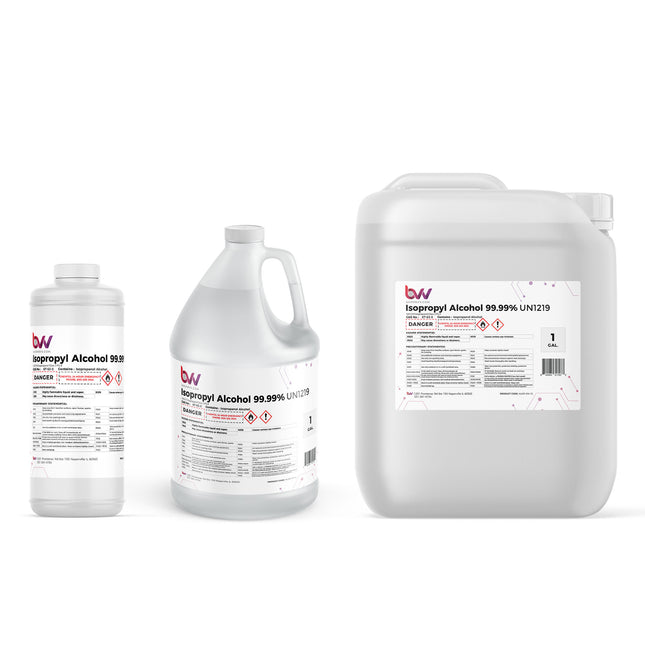
Isopropyl Alcohol 99% Tech Grade
Isopropyl Alcohol IPA 99% Isopropyl alcohol, also known as 2-propanol or rubbing alcohol, is one of the most common alcohol solutions. The exact mechanism behind isopropanol’s disinfectant is not certain, however, it’s believed to kill cells through the process of denaturing cell proteins and DNA, dissolving cell lipoprotein membranes, and obstructing cellular metabolism. Isopropanol has a range of applications and uses across multiple industries, from medicine to cosmetics, and we explore this below. Cleaning Agent for Extraction, Laboratory, and Medical Industries In addition, 99% pure isopropyl alcohol serves as a cleaning agent for the laboratory, medical, and extraction industries. Mixed with water, this solution can be used as a rubbing-alcohol antiseptic. Quality solvents are vital for cleaning delicate electronics, extraction equipment, and other sensitive items. It also makes a perfect solution for surface disinfectant. 99% IPA evaporates cleanly and minimizes residual substances. Cleaning Agent for Home Care A truly versatile solution used in a variety of applications, isopropyl can also serve as a home cleaning remedy. For example, many window and toilet bowl cleaners contain isopropyl alcohol. rubbing alcohol can dissolve icky residues such as chewing gum, sap, hairspray, and other difficult compounds from hands, surfaces, and more. Other ways isopropyl can be used: Cleaning makeup brushes Cleaning blinds Cleaning sinks and chrome Deodorizing shoes Disinfecting computer mouse and keyboard Disinfecting mobile phone Dissolving windshield frost Getting rid of fruit flies Cleaning jewelry Creating homemade sanitizer Preventing ring around the collar Cleaning stainless steel Other Things to Note Spigots/Faucets are only compatible with 5 Gallon Jugs and must be purchased separately Isopropyl alcohol is a fast-evaporating solvent and industrial cleaning agent, intended for industrial or professional use only. It can be used as a solvent for gums, shellac, and essential oils. Can be used as a fuel additive. Isopropyl Alcohol (liquid) - 99.8% Purity Shelf Life - 5 years Specific Gravity - 0.79 Vapor Pressure - 1psi @ 20°C Flash Point - 12°C *Disclaimer: 1 Quart Bottles are exempt from additional Hazmat shipping charges and can ship immediately, Less paperwork for shipping is required for shipping only 1 single bottle per order. Chemical Formula: C3H8O Molecular Weight: 60.096 g/mol CAS Registry Number: 67-63-0 Appearance Colorless Liquid Odor: Pungent Alcoholic odor Density 0.786 g/cm3 (20 °C) Boiling Point: 82.6 °C /180.7 °F Solubility in water: miscible GHS Pictograms: GHS Signal Word: Danger GHS Hazard Statements: H225, H302, H319, H336 GHS Precautionary Statements P210, P261, P305+P351+P338 UN Identification Number: 1219 Proper Shipping Name: Isopropanol Transport Hazard Class: 3 Packing Group: II DOT Placard: Isopropyl Alcohol Safety Data Sheet (SDS) Isopropyl Alcohol Certificate of Analysis (COA)
$23.84 - $3,996.22
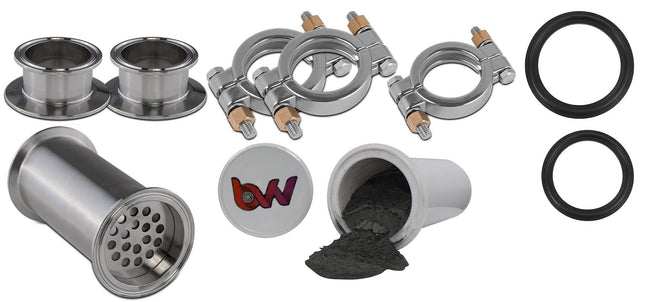
BVV Tri-Clamp Inline Filter Housing Kit with Free Sample Cartridge
BVV Tri-Clamp Inline Filter Housing Kit with Free Sample Cartridge Note: Extra Disposable cartridges sold separately. (Click Here for Cartridges) This inline housing allows for implementation of the BVV or AFS filters into many extraction systems. The BVV filter housing is 2.5" but comes with the adapter flanges for both ends to go inline with a standard 1.5" or 2" tri-clamp system. Kit Includes 1x Free BVV Sample Cartridge (55$ Value!) 2x 2.5" High Pressure Clamps 1x 1.5" or 2" High Pressure Clamp 1x 1.5" or 2" Buna-N Gasket 1x 2.5" Buna-N Gasket 2x Reducers 2.5" to 1.5" or 2" Tri-clamp 1x Cartridge Housing
$252.39
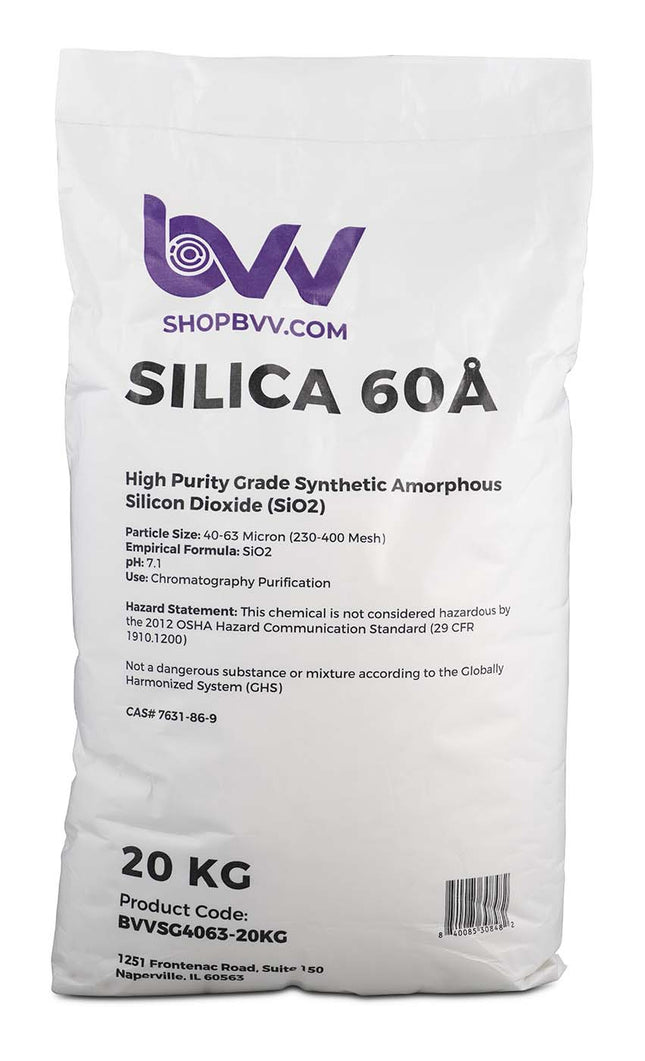
Silica Gel 60A 40-63 Micron CRC Grade
60A (40-63 Micron) Silica Gel High Purity Extraction CRC Grade The house brand Silica Gel is optimized for Color Remediation extractions. This powdered silica gel is for use in batch extractions and decolorizations. It can also be used as a general adsorbent for impurities. Optimized particle size, surface area, pH, and purity make it a particularly useful material for the separation of small molecules, peptides, lipids, alkaloids, and a variety of other compounds. Silica Gel is particularly useful to use layered on top of your bentonite to remove plant gums and waxes. BVVSG4063 Technical Data Sheet BVVSG4063 Certificate of Analysis BVVSG4063 Safety Data Sheet Key Specs: Particle Size: 40-63 Micron (230-400 Mesh) Pore Volume: 0.72 mL/g Loss on Drying: ≤ 2.0 wt% pH: 7.1 Empirical Formula: SiO2 Use: Decolorization Hazard Statement: No ingredients are hazardous according to OSHA criteria CAS# 7631-86-9
$588.92 - $11,042.18
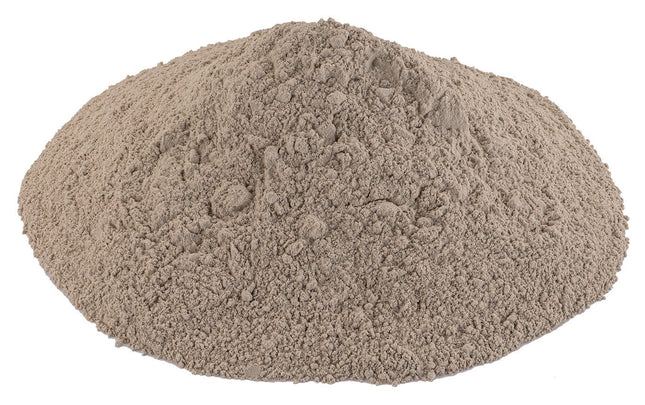
Perform 5000 Highly Acid Activated Bleaching & Decolorizing Bentonite
Pure-Flo® Perform 5000 Highly Activated Bentonite Clay for Bleaching & Decolorizing Edible Oils pH: 2.7 Pure-Flo® Perform 5000 provides superior bleaching activity for demanding oils. Effective with all types of difficult-to-bleach oil. Pure-Flo® Perform 5000 Technical Data Sheet.pdf Perform 5000 Safety Data Sheet Excellent metals adsorption characteristics (P, Ca, Fe, Mg, Ni, etc.) Excellent Chlorophyll removal Excellent Red and Blue color body removal. Removes soaps and phospholipids Outstanding filtration characteristics, including long filtration cycles and less pressure build up at cycle end. ph:2.7 FDA GRAS (Generally Recognized as Safe) - This product is safe for processing food, as long as its not part of the end product being consumed. NSF- HACCP *Prior to down packing this product was certified Kosher & Hallal. It does not retain its certifications after down packing, Sorry BVV™ doesn't have an on staff Rabbi or Imam on site to re-establish those certifications. Note: Bulk Bags and Bulk sizes are non-stocked items and will be ordered as needed and carry a several weeks lead time and require a forklift or pallet jack
$28.04 - $3,154.91
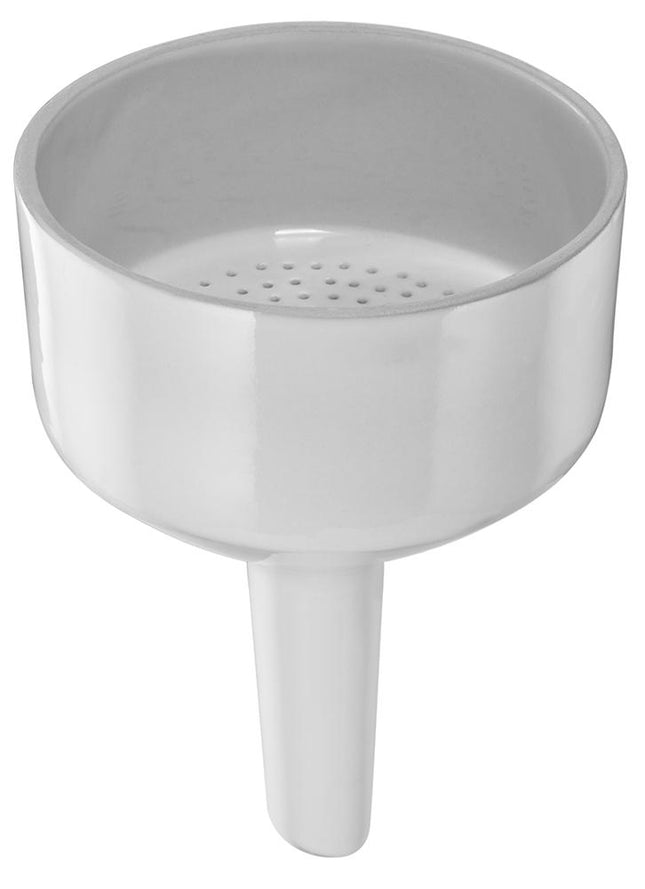
Porcelain Buchner Funnel
Porcelain Buchner Funnel Buchner funnel Porcelain Labware is used in the chemistry laboratory. It has exceptional resistance to all reagents except hydrofluoric acid and is highly resistant to thermal shock while having a very low coefficient of expansion. To prevent thermal stress cracks on porcelain ware do not exceed a heating/cooling rate of 200°C per hour. To prolong the life of porcelain products: · Follow gradual heating/cooling rates · Use an oven or hot plate and an intermediate step when quicker heating/cooling rates are required · Avoid contact of heated ware with a cold surface · Carefully check labware prior to each use and do not use any product that appears defective With straight sides above the perforated plate. Thick stem. Sizes Available: 1000ml - 5.5" (~140mm) Diameter 2000ml - 7-3/8" (~187mm) Diameter
$77.12 - $119.19
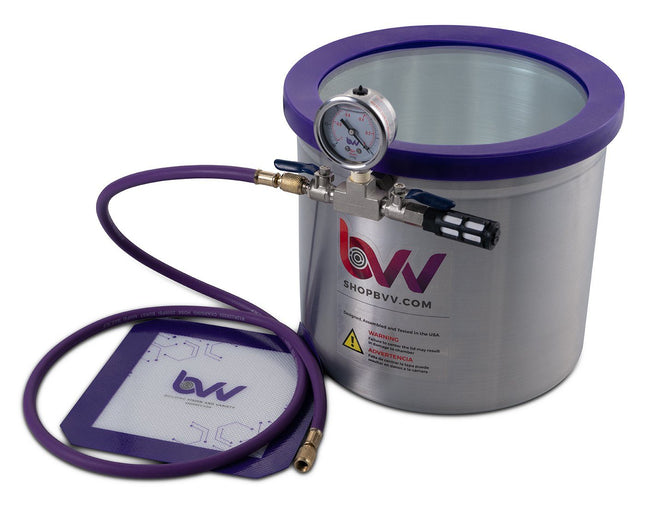
Glass Vac 3 Gallon Aluminum Vacuum Chamber
3 Gallon Vacuum & Degassing Chamber (Comes with 2 Year Limited warranty) This is a complete BestValueVac® vacuum chamber setup designed built and 100% tested in Naperville, Illinois. With our unique patent pending gasket design (Utility Patent #14/533,548) this chamber is sure to last 10,000 uses with proper care and maintenance. The gasket itself is reversible (doubling the life of our system) allowing customers to instantly take it off and flip it over. Every chamber is tested prior to shipping to lose no more than 2.5Hg/24hrs. Glass Vac Vacuum Chambers are ideal for wood workers using the wood stabilization process because the glass lid will not deteriorate like acrylic or polycarbonate lids. -Please Refer to these charts for vacuum specifications at altitude and conversions: Vacuum at Altitude Chart Vacuum Conversion Chart Key Features: Aluminum Vessel Highly Durable and Reversible Silicone Gasket Glycerin filled vacuum gauge User friendly vacuum connections that fit most vacuum pumps on the market 50 Micron Air filter for reducing airborne contaminants when releasing the vacuum Silicone vacuum pad 5' of vacuum rated HVAC hose to pull a vacuum. Specification Chamber Material 3004 Aluminum Gasket Material Silicone Lid Material Glass Internal Dimensions (ID) 9" Tall x 10" Diameter Vacuum Gauge (Glycerin Filled) InHG (0)-(-30) Manifold Connections 1/4" SAE and 1/4" FNPT Temperature Rating 150°F (65°C) Additional Included Items 5' Purple Vacuum Rated HVAC Hose Platinum Cured Silicone Pad Black 50 Micro Air Filter Compatibility Explanation: BestValueVac® Chambers are not compatible with stabilization resin (i.e. Cactus Juice™, Gator Venom™, Minwax™ etc.), alcohol, ethanol, acetone and acrylic based monomers or polymers.The lid may only be cleaned with soapy water. ShatterVac® chambers are not compatible with stabilization resin (i.e. Cactus Juice™, Gator Venom™, Minwax™ etc.), acetone, acrylic based monomers or polymers. The lid may be cleaned with soapy water and low strength cleaning agents. GlassVac® chambers are compatible with all solvents and stabilization resins. We only recommend and warranty GlassVac® chambers for resin infusion and wood stabilization.The lid may be cleaned with any solvent or cleaning agent. See FAQ at the top for product safety warnings. Pump Warranty Information: Customers using solvents such as stabilization resins (MinWax™, Gator Venom™ etc.), alcohol and other polar solvents must use the vacuum pumps in conjunction with a cold trap for evacuations in excess of 5 minutes. (Exludes Cactus Juice™) If the consumer is using the pump for prolonged periods of time exceeding 5 minutes we require that a cold trap is used or the pump warranty is void. These stabilization resins have the ability to break down the internal components of the pump that are plastic resulting in a seized motor voiding all warranties. When evacuation exceeds 5 minutes these solvents begin to vaporize and then re-condense in the vacuum pump reservoir. Once enough solvent re-condenses in the pump displacing the oil the plastic internal components may begin to warp, melt or seize. The use of a cold trap will condense the vapors prior to making their way to the vacuum pump preventing pump damage due to excessive use. Furthermore, Minwax Wood Hardener™ is not to be used with any vacuum pumps, EVER. (A seized motor will result within the first use.) To prevent these issues from happening to your process, change the Oil after each vacuum pump use, Even if the use time is only 5min. For shipping info including Import/Export details visit our Shipping link at the bottom of the page.
$215.94
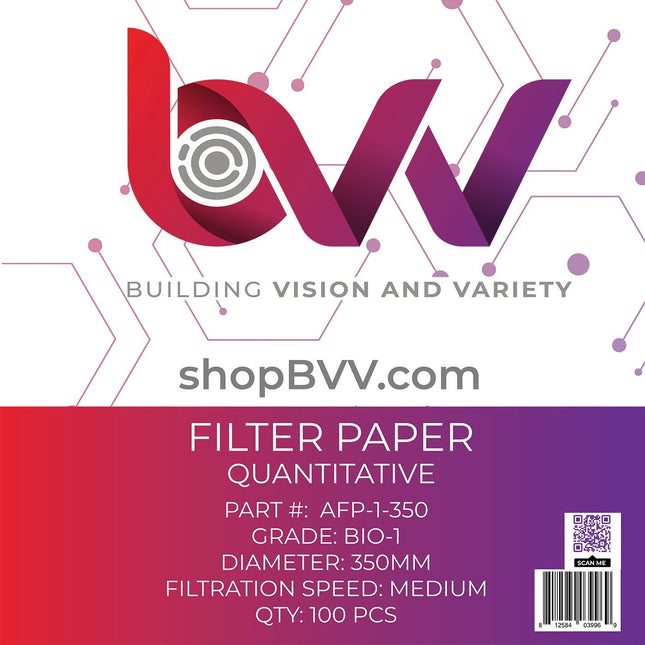
Ashless Filter Papers - 350MM - Quantitative
Ashless Filter Papers - 350MM - Quantitative Quantitative and qualitative filter papers provide laboratory grade filtration for extraction systems and are specifically used in combination with a Buchner funnel to remove fats, waxes and any other unwanted contaminants from your solution. These filter papers are used in the pre-processing stage of short path distillation to clean up the material prior to processing. Key Features: ISO 9001 Approved Manufactured from alpha-cellulose and cotton linters High Purity and low background Consistent performance Whatman equivalent quality Pre-Cut for ease of use Specifications: Classification Quantitative Sizes Available: AFP-1 11um - Medium AFP-4 20um - Fast Quantity per Pack 100 Diameter 350mm (13.78")
$133.21
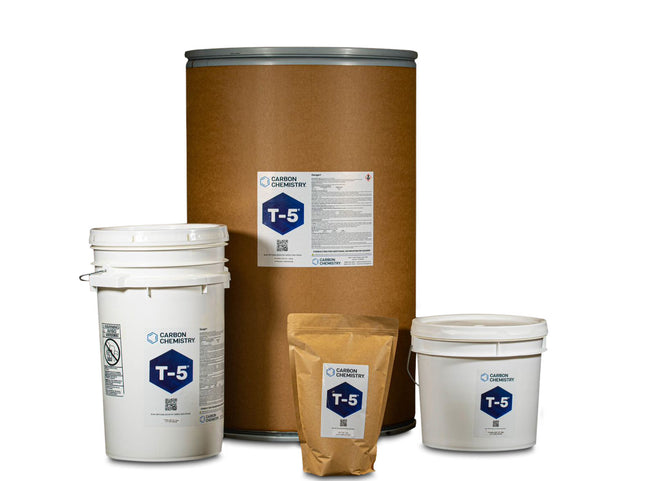
Carbon Chemistry MM Clay (T-5)
Carbon Chemistry MM Clay (T-5) A neutral powder media designed for best-in-class depth filtration and heavy metal removal. This thermally activated calcium bentonite clay provides superior support for separatory processes and excellent cation exchange capacity. The hardened clay structure and optimized surface chemistry make it ideal for both fine particulate removal and larger molecule capture. Carbon Chemistry T-5™ Neutral Activated Bentonite Clay - SDS Note: Bulk Bags and Bulk sizes are non-stocked items and will be ordered as needed and carry a several week lead time and require a forklift or pallet jack
$21.03 - $12,058.76
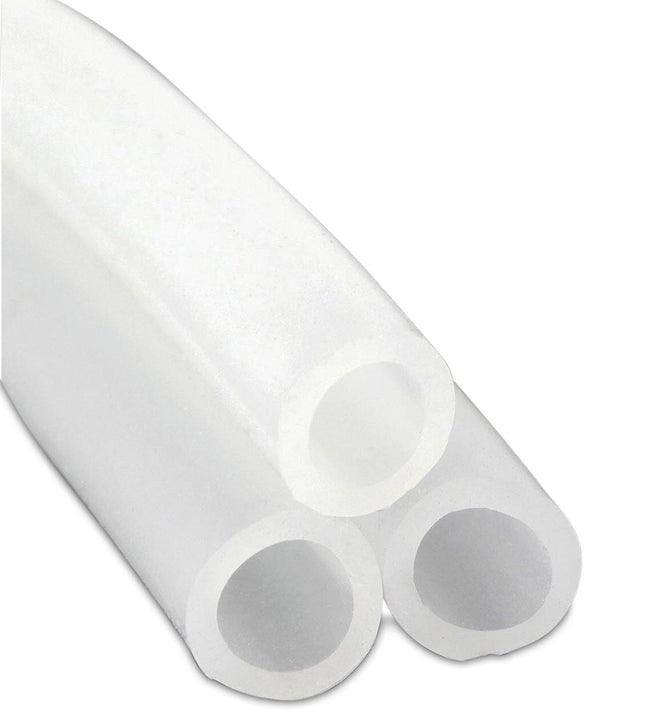
3/8" x 1/8" Wall - Heavy Duty Silicone Tubing For Flow
SILCON® Silicone Tubing (**Note: This tubing is only for flow and is NOT vacuum rated) The most outstanding properties of SILCON tubing are its flexibility and resistance to temperature extremes. These, plus its good electrical properties and ability to self-extinguish, make SILCON tubing an excellent choice for appliances and computers Peroxide-cured SILCON contains no sulfur or other acid-producing chemicals, thereby eliminating the possibility of staining, corroding, or deteriorating materials it contacts. It is extremely resistant to ozone and U.V. over long time periods. Care is recommended in the selection of fittings and clamps for SILCON as sharply barbed fittings or unlined metal clamps could tear into the tubing wall and possibly cause a failure. SILCON may be low-pressure steam sterilized in-line or autoclaved at up to 250°F in a normal autoclaving cycle. However, if exposed to repeated steam sterilization or long-term high temperature or pressure, silicone will eventually relax and become gummy. It should then be replaced. Please call or email Best Value Vacs to request different sizes and thickness (1/16" to 3/4"ID) - Colors for industrial applications are available through minimum order. Key Features: Made from FDA-sanctioned ingredients Able to resist extreme temperature variation: -100°F to 500°F Translucent natural color for visual contact with the flow resilient, stretchable, and resistance to compression set Odorless, tasteless and inert Good electrical and weatherability properties - resists U.V., ozone, gases, and moisture Certified by the National Sanitation Foundation (NSF-51) for food equipment materials MADE IN THE U.S.A. Specifications/Physical Properties Hardness, Shor A +/-5 50 Tensile Strength, PSI 1100 Elongation at Break % 375 Brittle Temperature °F -100 Max Operating Temperature °F 500 Max Operating Temperature for NSF °F 350 Comp. Set 22 Hrs. at 177°F, % 35 Tear Resistance (PPI minimum) 100 Tubing Specifications Chart ID (IN.) OD (IN.) STANDARD LENGTH WORKING PSI @ 70°F BURST PSI @ 70°F LBS PER 100FT 1/16 1/8 100 10 30 0.50 1/16 3/16 100 20 60 1.34 3/32 5/32 100 10 30 0.66 3/32 7/32 100 15 45 1.58 1/8 3/16 100 10 30 0.88 1/8 1/4 100 20 60 2.00 1/8 5/16 100 25 75 3.32 1/8 3/8 100 28 84 4.92 5/32 9/32 100 20 60 2.14 5/32 11/32 100 20 60 3.64 3/16 1/4 100 5 15 1.22 3/16 5/16 100 20 60 2.64 3/16 3/8 100 20 60 4.12 3/16 7/16 100 15 45 6.14 1/4 5/16 100 10 30 1.50 1/4 3/8 100 5 15 3.34 1/4 7/16 100 20 60 5.12 1/4 1/2 100 15 45 7.50 5/16 7/16 100 10 30 3.66 5/16 1/2 100 10 30 6.30 3/8 1/2 100 10 30 4.32 3/8 9/16 100 10 30 7.15 3/8 5/8 100 10 30 10.16 3/8 3/4 100 15 45 16.72 7/16 5/8 100 10 30 7.70 1/2 5/8 100 5 15 5.84 1/2 11/16 100 5 15 9.50 1/2 3/4 100 10 30 13.12 1/2 7/8 100 10 30 15.00 5/8 3/4 100 5 15 6.86 5/8 13/16 100 5 15 11.34 5/8 7/8 100 5 15 13.38 5/8 1 100 10 30 22.86 3/4 1 50 5 15 17.64 3/4 1-1/8 50 10 30 26.56
$47.67 - $350.55
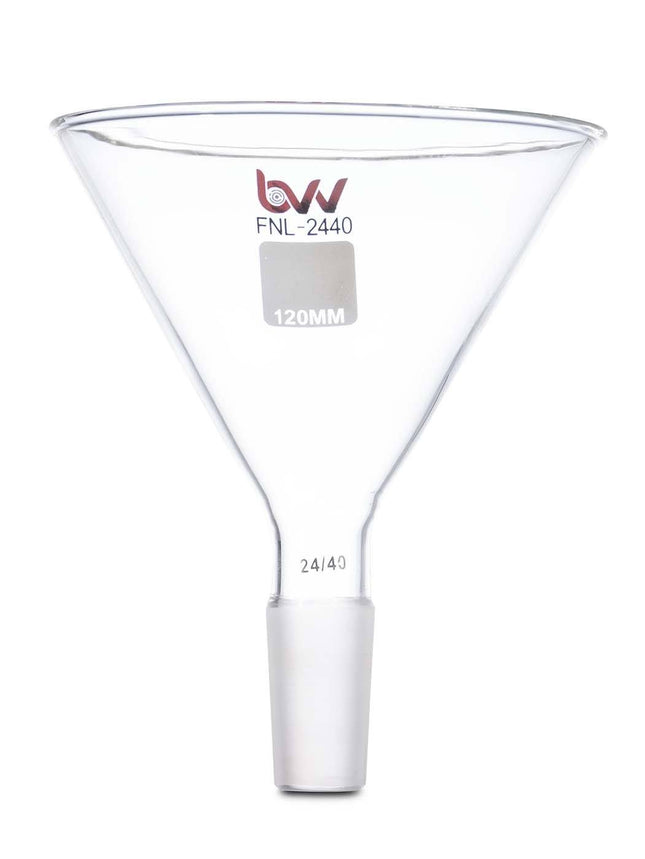
120mm Glass Funnel
120mm Glass Funnel 120mm Glass Funnel with 24/40 joint. *Notice to customers: All units are inspected for broken glassware or parts before leaving BVV™. If the unit arrives damaged (this does not include minor imperfections or scuffs in glassware), the customer MUST contact BVV™ within 72 hours from carrier delivery to file a claim. If the customer DOES NOT contact BVV™ within 72 hours from carrier delivery, then BVV™ cannot issue any replacement(s) or compensation for the item; a new purchase will need to be made for a replacement.
$30.85$21.03
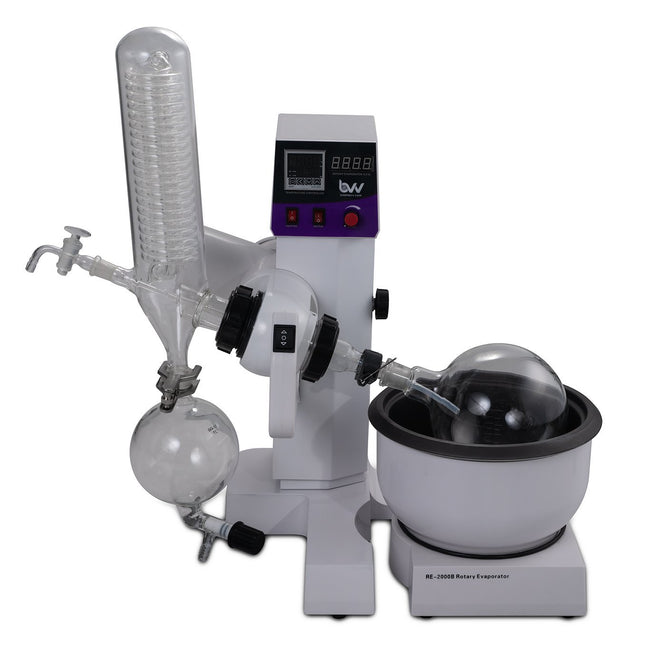
2L Electric Lift Rotary Evaporator
2L Electric Lift Rotary Evaporator The 2L BVV™ Electric Lift Rotary Evaporator is the ideal tabletop rotovap for small scale evaporation and recovery of solvents. Designed with ease of use in mind, the 2L allows users to separate solvents from a given mixture with minimal user input. The heating bath and temperature controls allow for precise, repeatable results. The double helix vertical condenser gives maximum surface area for condensation of vapors. PTFE seals on the entire system are made for maximum chemical resistance to ensure vacuum depth and lifespan of the system. Our rotovaps are a fraction of the price of more costly systems with the same functionaility and evaporation efficiency. 2L Best Value Electric Lift Rotovap Parts Diagram Features: Digital PID temperature and rotation speed control All PTFE valves for improved lifespan and chemical resistance Direct injection capability for continuous feeding of solution Small tabletop footprint Electric multi-level lifting mechanism for ease of use CE Listed 90-day limited warranty (excludes glassware, consumables & moving parts) Specifications: Model 2L Best Value Electric Lift Rotary Evaporator Optimum Ambient Temperature 5~25C / 41~105.8F Glass Material GG-17 High Borosilicate Power (V/Hz) 110V 60Hz Speed Regulation Digital Step-less Regulation Rotation Speed 20-198 RPM Set Temperature 0-99C / 0-210F Temperature Control Digital Temperature Control Maximum Vacuum Pressure -29.8 inHg Evaporating Flask Capacity 2L (2000mL) Receiving Flask Capacity 1L (1000mL) Condenser Style Vertical Double Helix Evaporation Capacity Alcohol >/= 1 L/H Heater Max Current Draw (Amps) 13.6 Water Bath Material Teflon Composite Water Bath Size 10 x 5 in. Lifting Function Electric Lifting Stroke 14cm / 5.5 in. Total Power Consumption (kW) 1.8 kW Dimensions 28 x 18 x 27 in. Weight 37.2 kg / 82 lbs Vacuum Connection 3/8” Barb Condenser Connection 3/8” Barb Warranty 90 days excluding glass parts Certifications CE Rotovap Quick Start Guide This guide gives basic quick start instructions for rotovaps. It is intended to provide a starting point for learning the process. Parameters should be adjusted to suit specific needs. Clean and assemble unit. Make sure all pieces are cleaned and sterilized using an alcohol solution. Connect chiller to condenser and set to 0C (32F). Always fill a rotovap condenser from the top down (chiller output to top of condenser, chiller input to bottom of condenser). Connect vacuum pump to cold trap and connect cold trap to vacuum port on rotovap. Turn on heat bath and set to 40C (113F). Once heat bath, chiller and cold trap have reached desired temperatures, turn on rotovap motor and set speed to approximately 100 RPM (does not have to be precise). Keep in mind, higher RPM’s will increase evaporation power but also increase heat load. Start vacuum pump and allow vacuum to pull down for a few minutes before injection. Once vacuum has been pulled to a sufficient level (does not have to be precise but should be below 100 Torr), using the injection valve, very slowly inject approximately 500 mL of solution into evaporating flask and then close the valve. Allow this small amount to begin evaporating. You may see the chiller begin to rise in temperature, this is called “priming” the rotovap. Once the temperature stops rising or all liquid is almost completely evaporated, open the injection valve again very slowly so that a small amount of liquid begins to enter the evaporating flask. Do not close injection valve this time but continue to allow solution to enter the evaporating flask. At this point you must try to match the input speed to the output speed. What this means is that you should be injecting the same amount of liquid into the rotovap that is equal to the amount of liquid dripping from the condenser into the receiving flask. You will know that the input speed and output speed are matched because the chiller will remain at a stable temperature. If the chiller begins to rise, then you are injecting too much liquid. Dial back the valve until the chiller stabilizes. Once everything is stabilized, you may walk away from the rotovap if necessary. Check every so often to make sure temperatures remain stable and evaporation continues efficiently. ***Note: All units are inspected for broken glass or parts before unit is shipped. If unit arrives damaged or glass is broken (this does not include minor imperfections or scuffs in glassware), Customer MUST contact BVV™ within 3 days of delivery to file a claim and receive a replacement part. If customer DOES NOT contact BVV™ within 3 days of delivery responsibility for replacement parts falls on the customer and they must pay for replacement pieces.*** ***Glassware Safety Disclaimer: BVV™ is not responsible for failure of glassware which must be inspected before and after every use because it may eventually develop imperfections or damage through normal usage, mishandling, and stress caused by temperature variations. If an imperfection or damage is noted while inspecting the glassware DO NOT use the glassware because it can fail causing bodily harm or damage to the surrounding area.***
$2,173.38 - $2,383.71
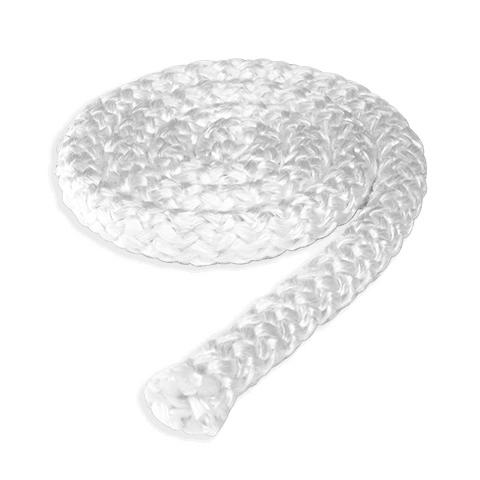
Fiberglass Insulation Rope 10 Feet
Fiberglass Insulation Rope 10 Feet ***Caution: Always use proper protection when working with fiberglass. Avoid skin and eye contact.*** Ten feet of white 1/2" fiberglass insulation rope. Used to wrap the upper half of boiling flasks. Specifications: Width: 1/2" Material: Fiberglass Maximum Temperature: 1000F Resistant to solvents, acids, and bleach Color: White Length: 10 ft. (20ft needed for 5L Flask.)
$39.26
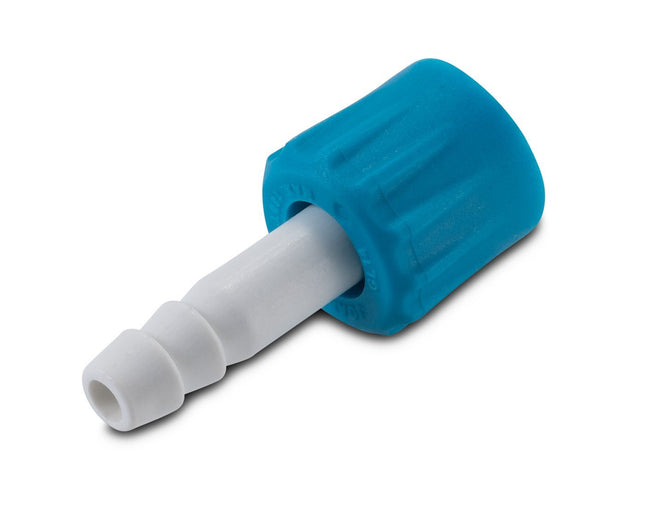
Straight GL-14 Barb
Straight GL14 Barb Straight GL14 Barb connection Specifications: 8MM GL14 Female Connection Straight Style
$9.82

Carbon Chemistry SD (Silica 60A)
Carbon Chemistry SD (Silica Gel 60A) A high-purity silica powder media optimized for precise separation and purification processes. This carefully engineered adsorbent provides exceptional control in chromatographic applications and targeted compound removal. Its optimized surface chemistry makes it particularly effective for polar compound separation and analytical-grade purification needs. This powder is used often in Column Chromatography as the stationary phase. It is mixed together with the solvent in the column making a slurry, then letting the solvent drain leaving the Silica sitting evenly in the column. Silica Gel helps space out or separate the fractions of compounds being passed through the stationary phase. Carbon Chemistry Silica Gel 60A, 200-400 MESH - SDS Note: Bulk Bags and Bulk sizes are non-stocked items and will be ordered as needed and carry a several week lead time and require a forklift or pallet jack
$140.22 - $18,228.36

3 Finger Clamp Adjustable 0-70mm
3 Finger Clamp Adjustable Up to 70mm 3 Finger Clamp has an adjustable diameter of up to 70mm. Ideal for holding workpieces, lab equipment, beakers, flasks, flashlights, webcams, etc. Three-finger clamps are used to hold larger pieces of glassware.
$33.65
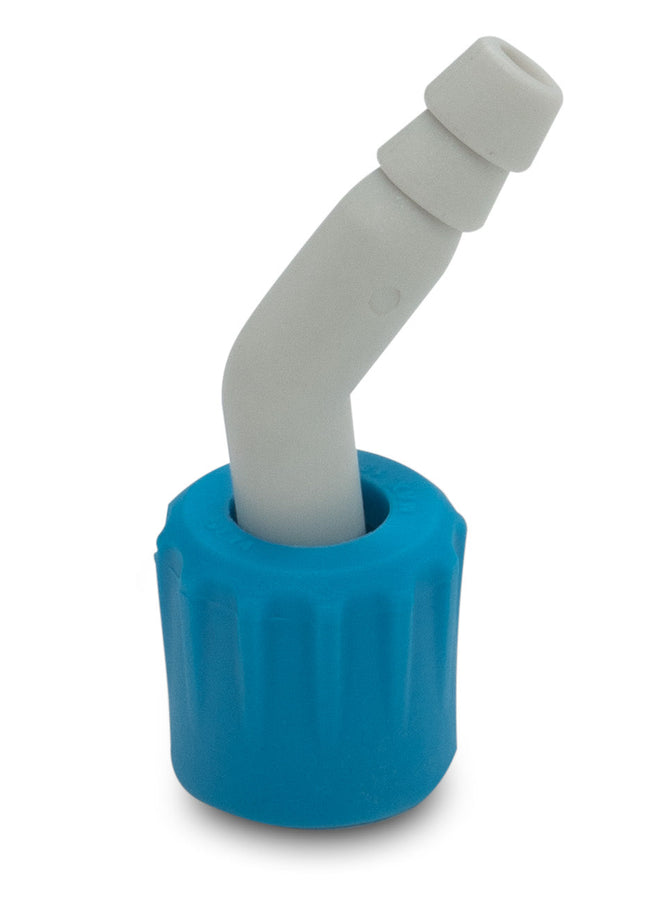
Angled GL-14 Barb
Angled GL14 Barb Disclaimer: This item may come in either a Red or Blue color. Angled GL14 Barb Connection. Specifications: 8MM GL14 Female Connection Angled Style
$8.41
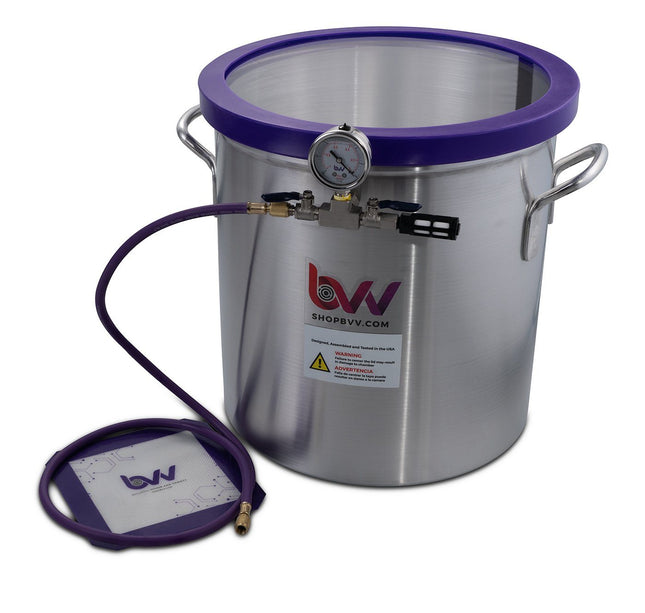
Glass Vac 15 Gallon Aluminum Vacuum Chamber
Glass Vac 15 Gallon Aluminum Vacuum Chamber (Comes with 2 Year Limited warranty) This is a complete BestValueVac® vacuum chamber setup designed built and 100% tested in Naperville, Illinois. With our unique patent pending gasket design (Utility Patent #9475627) this chamber is sure to last 10,000 uses with proper care and maintenance. The gasket itself is reversible (doubling the life of our system) allowing customers to instantly take it off and flip it over. Every chamber is tested prior to shipping to lose no more than 2.5Hg/24hrs. Glass Vac Vacuum Chambers are ideal for wood workers using the wood stabilization process because the glass lid will not deteriorate like acrylic or polycarbonate lids. -Please Refer to these charts for vacuum specifications at altitude and conversions: Vacuum at Altitude Chart Vacuum Conversion Chart Key Features: Aluminum Vessel Chemically Inert Glass Lid Highly Durable and Reversible Silicone Gasket Glycerin filled vacuum gauge User friendly vacuum connections that fit most vacuum pumps on the market 50 Micron Air filter for reducing airborne contaminants when releasing the vacuum Silicone vacuum pad 5' of vacuum rated HVAC hose to pull a vacuum. Specification Chamber Material 3004 Aluminum Gasket Material Silicone Lid Material Glass Internal Dimensions (ID) 17.2" Tall x 16-1/8" Diameter Vacuum Gauge (Glycerin Filled) InHG (0)-(-30) Manifold Connections 1/4" SAE and 1/4" FNPT Temperature Rating 150°F (65°C) Additional Included Items 5' Purple Vacuum Rated HVAC Hose Platinum Cured Silicone Pad Black 50 Micro Air Filter Compatibility Explanation: BestValueVac® Chambers are not compatible with stabilization resin (i.e. Cactus Juice™, Gator Venom™, Minwax™ etc.), alcohol, ethanol, acetone and acrylic based monomers or polymers.The lid may only be cleaned with soapy water. ShatterVac® chambers are not compatible with stabilization resin (i.e. Cactus Juice™, Gator Venom™, Minwax™ etc.), acetone, acrylic based monomers or polymers. The lid may be cleaned with soapy water and low strength cleaning agents. GlassVac® chambers are compatible with all solvents and stabilization resins. We only recommend and warranty GlassVac® chambers for resin infusion and wood stabilization.The lid may be cleaned with any solvent or cleaning agent. See FAQ at the top for product safety warnings. Pump Warranty Information: Customers using solvents such as stabilization resins (MinWax™, Gator Venom™ etc.), alcohol and other polar solvents must use the vacuum pumps in conjunction with a cold trap for evacuations in excess of 5 minutes. (Exludes Cactus Juice™) If the consumer is using the pump for prolonged periods of time exceeding 5 minutes we require that a cold trap is used or the pump warranty is void. These stabilization resins have the ability to break down the internal components of the pump that are plastic resulting in a seized motor voiding all warranties. When evacuation exceeds 5 minutes these solvents begin to vaporize and then re-condense in the vacuum pump reservoir. Once enough solvent re-condenses in the pump displacing the oil the plastic internal components may begin to warp, melt or seize. The use of a cold trap will condense the vapors prior to making their way to the vacuum pump preventing pump damage due to excessive use. Furthermore, Minwax Wood Hardener™ is not to be used with any vacuum pumps, EVER. (A seized motor will result within the first use.) To prevent these issues from happening to your process, change the Oil after each vacuum pump use, Even if the use time is only 5min. For shipping info including Import/Export details visit our Shipping link at the bottom of the page.
$586.11
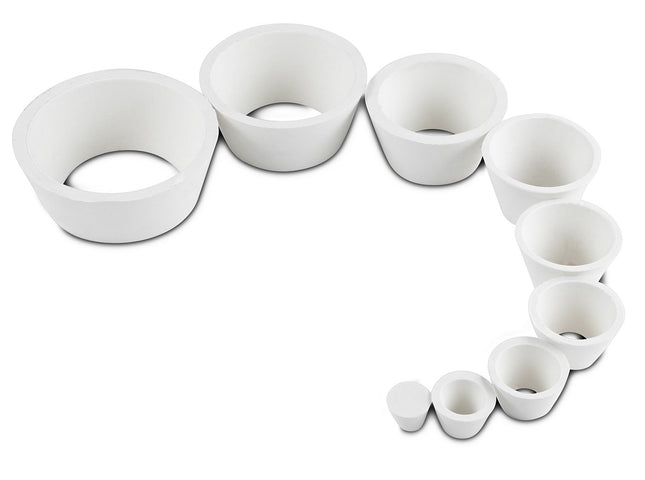
Rubber Cones Set of 9
These rubber cones are used for adapting and creating a seal on buchner funnel systems or applications where varying sizes are needed. Color is white and comes with 9 comes the smallest one being a solid stopper.
$28.04
You have seen 48 out of 204 products
















































